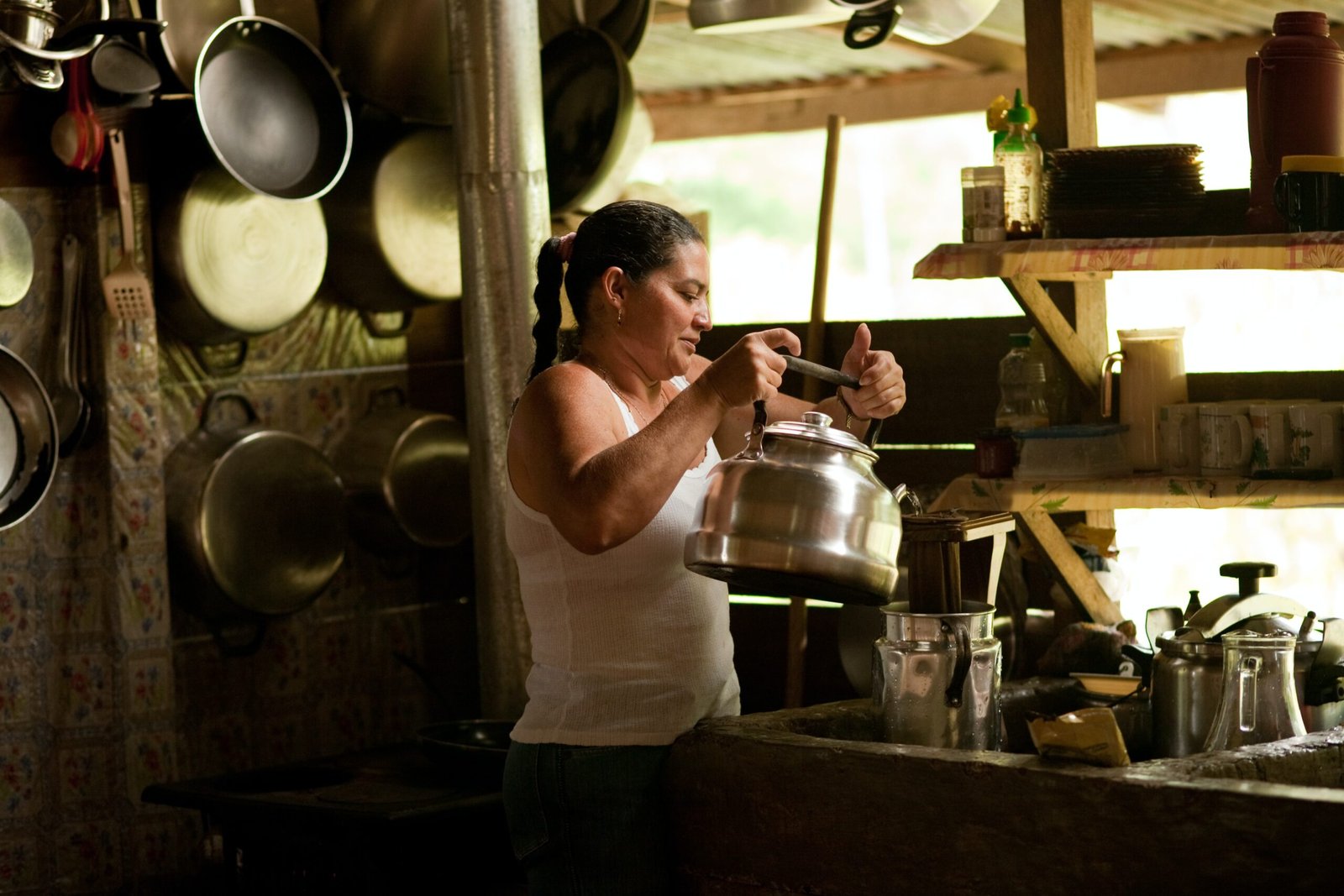Take Me to the Recipes
Beyond the Rainforests: A Culinary Adventure in Costa Rica 🇨🇷
Costa Rica, a Central American haven renowned for its lush rainforests, volcanic peaks, and commitment to sustainability, boasts more than just breathtaking scenery. Nestled beneath the vibrant canopy lies a world of unexpected culinary delights. Costa Rican cuisine, much like the country itself, is a harmonious blend of influences, reflecting its rich history, diverse geography, and perfect tropical climate.
Indigenous traditions laid the foundation, with corn, beans, and root vegetables forming the backbone of the diet. Spanish colonization added European staples like rice, wheat, and dairy, while African influences introduced plantains and unique cooking techniques. This fusion of cultures creates a vibrant culinary tapestry, where fresh, local ingredients take center stage. From the Caribbean coast’s emphasis on seafood to the mountainous regions’ hearty stews, Costa Rican cuisine offers a delicious journey through the country’s varied landscapes.
But the story doesn’t stop there. Costa Rica’s ideal climate, with its abundance of sunshine and fertile volcanic soil, allows for a flourishing agricultural industry. This, in turn, translates to an abundance of fresh fruits, vegetables, and herbs that infuse dishes with an explosion of flavor.
So, buckle up for a taste bud tantalizing adventure! We’re diving deep into the heart of Costa Rican cuisine, exploring how history, geography, and climate have conspired to create a culinary scene that’s both delicious and distinct.
Take Me to the Recipes
Costa Rican Cuisine – Key Takeaways
- Costa Rican cuisine is influenced by a rich history, abundant natural resources, and diverse geography.
- The cuisine is characterized by its emphasis on fresh, locally sourced ingredients and a balance of flavors.
- Rice and beans are staple ingredients and feature prominently in many dishes.
- Fruits, vegetables, and tropical flavors play a significant role in Costa Rican cooking.
- Traditional dishes are often served with corn tortillas or plantains.
- Coffee holds a special place in Costa Rican culture and is a key part of their cuisine.
Where is Costa Rica?

Costa Rica is located in Central America, connecting North and South America. It borders Nicaragua to the north and Panama to the south.

Index to the Contents
- Take Me to the Recipes
- More Articles
- 10 Fascinating Facts about Costa Rica
- Costa Rica’s History and the Effect It Has Had on the Cuisine
- How Costa Rica’s Climate and Geography Have Influenced the Cuisine
- Understanding the Essence of The Costa Rica Cuisine
- Costa Rican Culinary Traditions
- Exploring Costa Rica’s Ingredients
- Mastering Costa Rican Cuisine Cooking Techniques
- Traditional Costa Rican Food
- Exploring Costa Rican Street Food
- The Most Popular the Costa Rican Recipes
- What are the Health Implications of Costa Rican Cuisine?
- Costa Rica’s National Dish
- Costa Rican Recipes you can try in your own kitchen
- Conclusion
- FAQ’s
You may also Enjoy the Following Articles
- North and South American Cuisine – A Culinary Expedition
- Europe Cuisine: Savor the Continent’s Best Culinary Secrets!
- African Cuisine: Discover the Bold Flavors & Global Charm!
- Asian Cuisine Unlock its Secrets – Taste, Health & Global Influence!
- Oceania Cooking: A Culinary Journey Through the Pacific
Savor iconic Costa Rican Food Recipes – Click on each tantalizing picture to open up the Recipe.





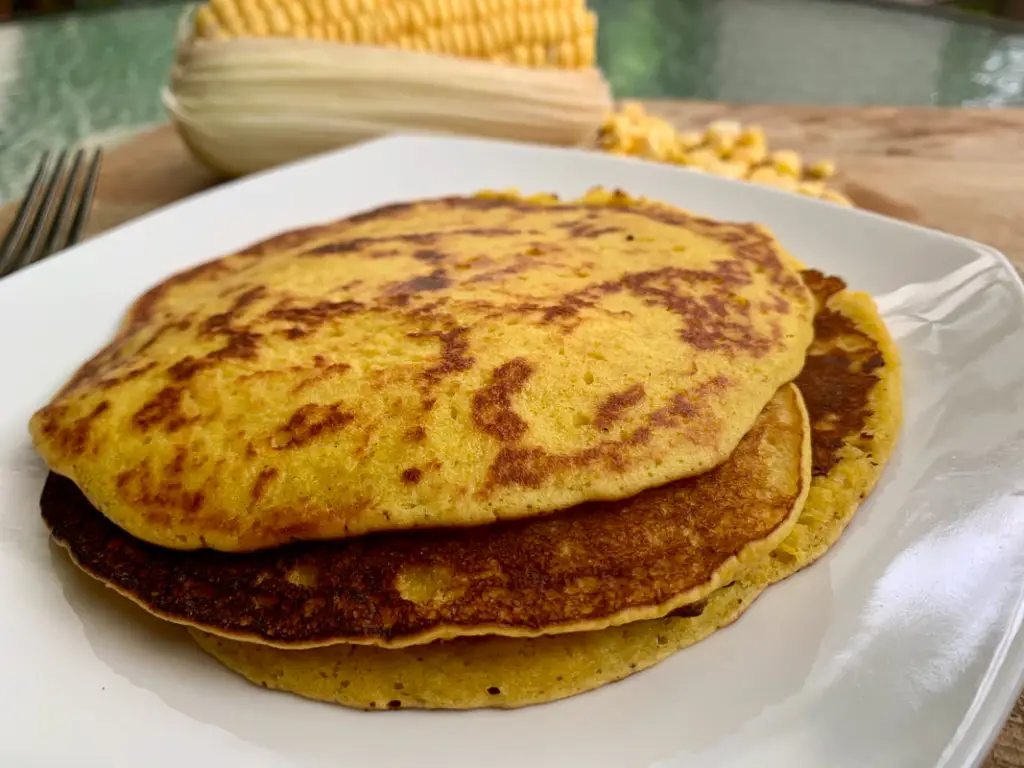




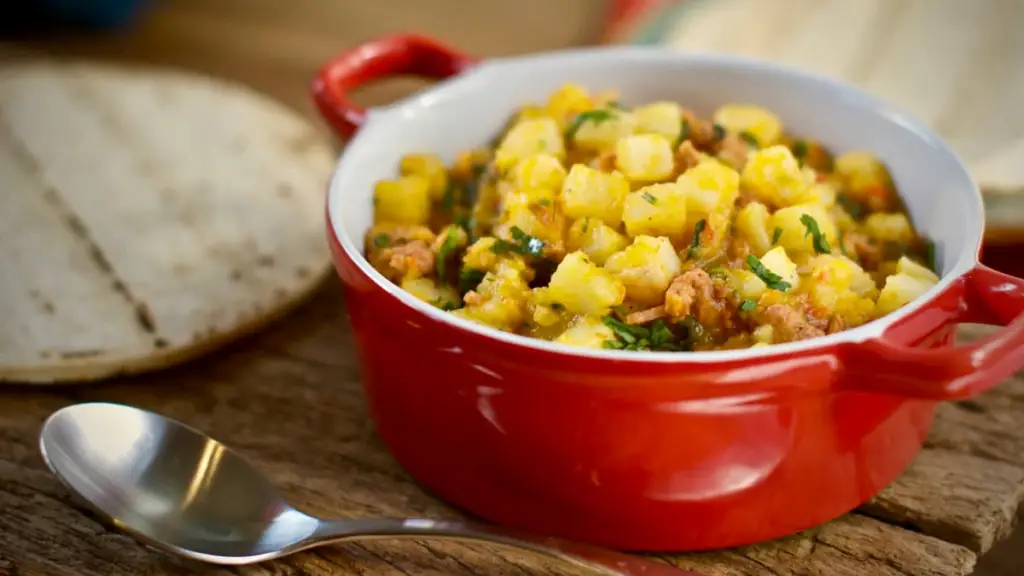



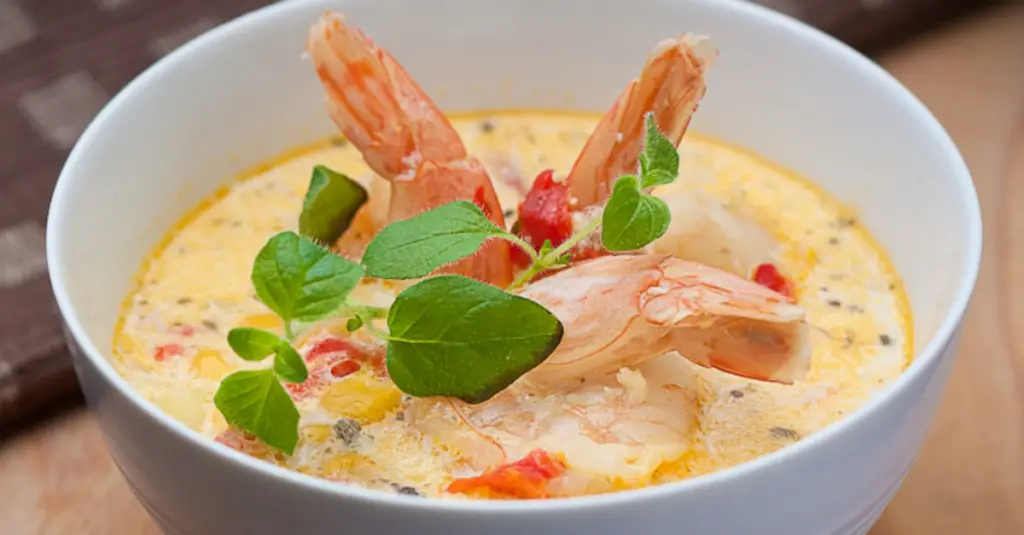






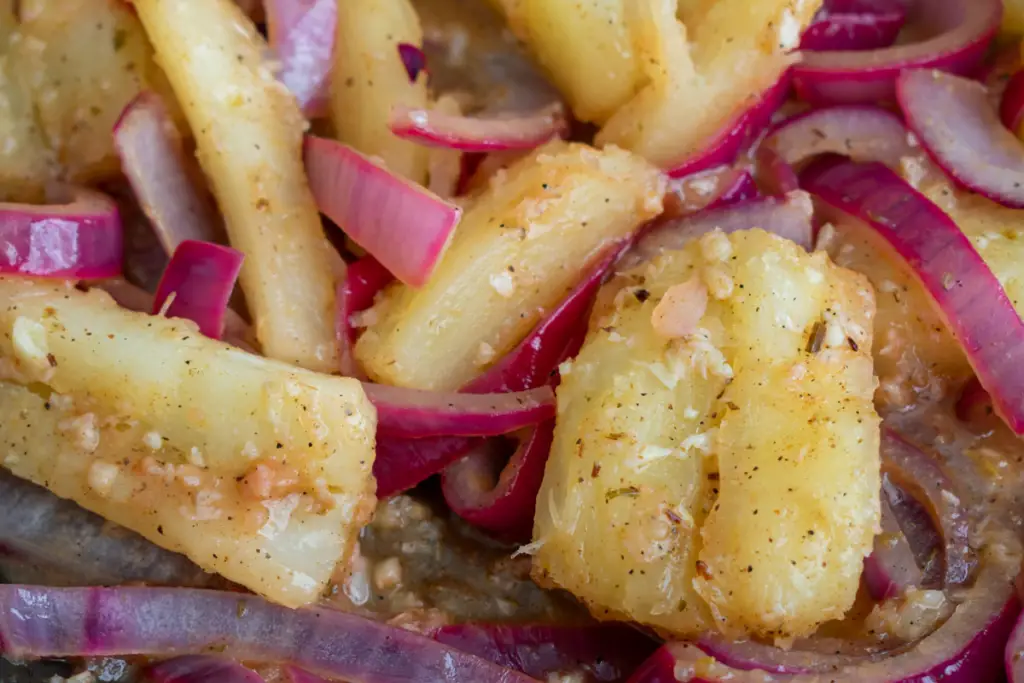
10 Fascinating Facts about Costa Rica

Costa Rica, the “Rich Coast,” isn’t just a haven for eco-tourists and adrenaline junkies. This vibrant Central American nation boasts a rich history, stunning landscapes, and a surprising collection of quirky laws and fascinating facts. Buckle up for a dose of Tico trivia (Tico being a slang term for Costa Rican) that will leave you both amused and enlightened:
Peace Out, Military
Since 1949, Costa Rica has abolished its military, choosing to invest in education and social programs instead. This makes it one of the few countries in the world to rely solely on a police force.
Pura Vida Paradise
“Pura vida” (pure life) isn’t just a motto; it’s a way of life in Costa Rica. This philosophy emphasizes a laid-back approach, focusing on enjoying the simple things and appreciating nature’s bounty.
Sloth Capital of the World
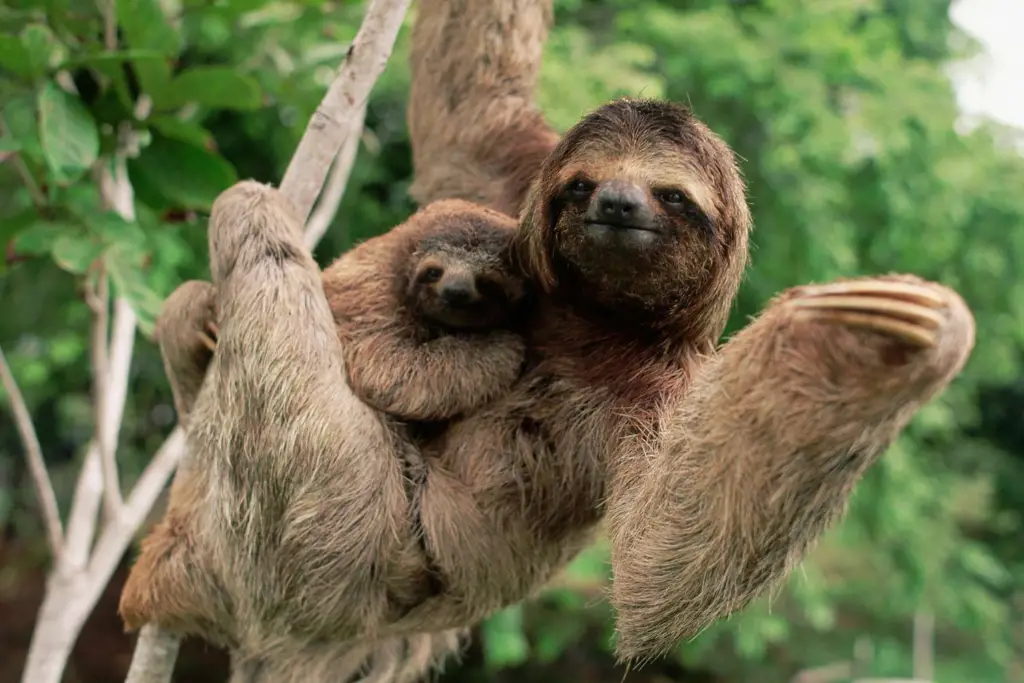
Move over, koalas! Costa Rica, with its lush rainforests, is a haven for sloths. With two-toed and three-toed sloth species hanging out in the trees, you might just spot one of these slow-moving mammals on your visit.
Coffee Connoisseur’s Dream
Costa Rican coffee is world-renowned for its rich flavor and smooth taste. Volcanic soil, ideal climate, and meticulous harvesting techniques contribute to the exceptional quality of these beans.
Butterflies by the Billions

Brace yourself for a breathtaking spectacle! During their migration, billions of monarch butterflies blanket the forests of Costa Rica, transforming trees into fluttering tapestries of orange and black.
Avian Acrobats: The Resplendent Quetzal
Keep your eyes peeled for the national bird of Costa Rica, the resplendent quetzal. This emerald, green bird with a flowing turquoise tail feather is a dazzling sight and a symbol of national pride.
Surfing Nirvana

Catch a wave (or at least try to)! Costa Rica’s Pacific and Caribbean coasts offer some of the world’s best surfing conditions, attracting beginners and seasoned surfers alike.
Volcanic Hot Spots
Costa Rica boasts over 100 volcanoes, some active and others dormant. Take a dip in natural hot springs heated by volcanic activity, a truly unique and geothermal experience.
Jungle Jacuzzis: Hidden Waterfalls Abound

Costa Rica’s hidden waterfalls offer a refreshing and picture-perfect escape. Hike through lush rainforests and discover cascading waters perfect for a dip in a natural jacuzzi.
Hello Toucans, Goodbye Plastic Bags
Costa Rica is a leader in eco-tourism and sustainability. The country banned single-use plastic bags in 2018, reflecting its commitment to preserving its natural beauty for generations to come.
Costa Rica’s History and the Effect It Has Had on the Cuisine

Costa Rica’s lush rainforests and pristine beaches aren’t just a feast for the eyes; they’re a reflection of a rich history that continues to tantalize taste buds today. Let’s embark on a delicious adventure, exploring how different historical periods shaped Costa Rican cuisine into the vibrant tapestry it is today:
Pre-Columbian Era (Before 1500): A Celebration of Corn
Long before European arrival, the indigenous people of Costa Rica, like the Chorotega, lived in harmony with their environment. Their diet revolved around the bounty of the land, with maize (corn) taking center stage.
This versatile grain was transformed into tortillas, used in soups and stews, and became the base for a cherished celebratory dish – the tamale. Introduced by the Aztecs, tamales are made from corn dough, stuffed with savory fillings like meat, rice, and vegetables, then wrapped in banana or plantain leaves.
Steamed to perfection, they’re a delicious testament to the ingenuity of Costa Rican indigenous cuisine.
Spanish Conquest (Early 16th Century): A Fusion of Flavors

In 1503, Christopher Columbus set foot in Costa Rica, ushering in the era of Spanish colonization. The Spanish conquerors incorporated the territory into the Captaincy General of Guatemala, leaving a significant mark on Costa Rican culture, including its cuisine.
While new ingredients like rice, wheat, and dairy were introduced, the importance of corn remained. Tamales continued to be a cherished dish during celebrations, showcasing the beautiful adaptability of Costa Rican cuisine.
Independence and Post-Colonial Era (19th Century): Finding its Footing
The 19th century saw Costa Rica navigate the tides of independence. After the Mexican War of Independence in 1821, Costa Rica gained freedom from Spain. Corn continued to be a staple across the country, featuring prominently in local dishes.
The nation briefly joined the Federal Republic of Central America before declaring full independence in 1828. However, a lack of strong European connections led to economic challenges, impacting food availability and influencing culinary practices.
Modern Period (20th Century): A Shift Towards Sustainability

The 20th century brought significant changes to Costa Rica. Following the Costa Rican Civil War in 1948, the government focused on a new constitution, dismantling the military and promoting social programs. Today, Costa Rica thrives on a strong focus on technology and eco-tourism.
This shift is also reflected in its cuisine. Rice and beans, a hearty and affordable combination, have become staples in nearly every Costa Rican meal, particularly breakfast. Alongside these staples, pork, beef, chicken, and fish are commonly enjoyed, often accompanied by potatoes.
But Costa Rica’s love affair with indigenous ingredients continues with the versatility of plantains. Ripe plantains are enjoyed fried, baked in sweet sauces, or even incorporated into soups.
Caribbean Coast Influence: A Spicy Twist
Costa Rica’s Caribbean coast boasts its own unique culinary traditions. Influenced by Afro-Caribbean heritage, dishes like pork cracklings and hearty tripe soup (mondongo) add a vibrant touch to festive occasions.
However, even the ubiquitous rice and beans differ slightly on the Caribbean side. Cooked in rice water instead of the usual black bean broth, they are typically served with flavorful fish and fried plantains.
From the legacy of indigenous corn to the Spanish introduction of rice, and the vibrant flavors of the Caribbean coast, Costa Rican cuisine is a delicious tapestry woven from centuries of history and cultural exchange.
Every bite tells a story of resilience, adaptation, and a deep appreciation for the land’s bounty. So, the next time you savor a Costa Rican dish, take a moment to appreciate the fascinating journey that brought it to your plate.
References
- Wikipedia: History of Costa Rica
- GVI: Discovering the Culture and Cuisine of Costa Rica
- The Salty Cooker: Your Ultimate Guide to Costa Rican Cuisine
- National Geographic: Where the Caribbean Meets Costa Rica
How Costa Rica’s Climate and Geography Have Influenced the Cuisine

Buckle up for a culinary adventure as we explore how these factors shape Costa Rican cuisine:
Nature’s Bounty: A Gift from Location and Climate
Imagine a land bathed in sunshine all year round. Costa Rica’s equatorial position makes this a reality, ensuring a constant supply of fresh fruits, vegetables, and herbs. This, combined with the fertile volcanic soil, creates a paradise for agriculture. No wonder fresh produce takes center stage in Costa Rican cuisine!
From Mountains to Coasts: A Regional Tapestry of Flavors
Costa Rica’s diverse landscape plays a starring role in its cuisine. Coastal regions boast an abundance of fresh seafood, while the mountainous areas are havens for coffee, unique fruits, and vibrant vegetables. Let’s delve deeper into some of the regional specialties:
Central Valley (Heart of Costa Rica)

The bustling Central Valley, centered around San José, is a melting pot of influences. Here, you’ll find a delightful mix of traditional “tico” cuisine (think gallo pinto, casados, and desayuno tipico) alongside a vibrant array of international flavors, reflecting San José’s role as a major trade hub.
Pacific North (La Pampa)
Step back in time and experience the warmth of homemade cooking in the Pacific North. Family-owned farms flourish here, producing fresh ingredients like cheese and corn, the cornerstone of the region’s cuisine.
Don’t miss chorreadas, a must-try dish featuring handmade corn pancakes. Traditional techniques like open-air wood-burning kitchens and hand-ground meals add to the charm of this culinary experience.
Caribbean Coast (Province of Limón)

The Afro-Caribbean influence shines brightly on the Caribbean coast, particularly in Puerto Limón. Here, classic Costa Rican dishes get a delightful twist with the addition of Afro-Caribbean traditions.
Expect to find a prominent role for tubers like yam and yucca, alongside tropical delights like callaloo, ackee, okra, and coconut. Don’t miss Rondon, a hearty stew simmered in coconut milk and brimming with fish, seafood, yucca, and vegetables – a true Limón specialty.
Other Regions
The culinary journey doesn’t stop there! Guanacaste is known for its refreshing horchata (a spiced cornmeal drink) and delectable grilled meats. The Nicoya Peninsula tempts with fresh seafood and tropical fruits, while the Southern Coast boasts rich coffee plantations and a treasure trove of exotic fruits.
A Celebration of Tradition and Adaptation
Costa Rican cuisine is a vibrant mosaic, a testament to the country’s natural bounty and rich cultural tapestry. Each bite tells a story – of tradition passed down through generations, adaptation to a diverse landscape, and a deep love for fresh, local ingredients.
So, whether you savor the comforting flavors of gallo pinto in San José or indulge in a steaming bowl of rondon on the Caribbean coast, remember – you’re not just eating a meal, you’re experiencing the essence of Costa Rica on your plate.
References
- National Geographic: Where the Caribbean Meets Costa Rica
- Understanding Costa Rica Weather and Climate: A Guide
- Costa Rica Cultural Cuisine
Understanding the Essence of The Costa Rica Cuisine

Nestled in the heart of Central America, Costa Rica beckons with its lush landscapes, abundant biodiversity, and a culinary scene that dances with a unique rhythm. As we delve into the essence of Costa Rican cuisine, we find a tapestry woven from diverse influences, showcasing the nation’s rich history and vibrant cultural mosaic.
A Melting Pot of Influences
Costa Rican cuisine is a harmonious blend of indigenous, Spanish, African, and Caribbean flavors. The indigenous people, including the Chorotega and Huetar, laid the foundation with their reliance on staples like maize, beans, and tubers.
The Spanish brought a medley of spices, livestock, and culinary techniques, while African influences infused the cuisine with a soulful depth, marked by vibrant spices and traditional dishes.
Pura Vida on the Plate
“Pura Vida,” the iconic Costa Rican phrase meaning “pure life,” is not just a saying; it’s a way of life reflected in their food. Simplicity is key, with a focus on fresh, locally sourced ingredients.
The emphasis on sustainability and organic farming adds an extra layer to the culinary experience, creating a connection between the plate and the lush landscapes that surround.
The Stars of Costa Rican Cuisine
1. Gallo Pinto
Gallo Pinto, the national dish, embodies the soul of Costa Rican breakfasts. A delectable combination of rice, black beans, peppers, onions, and a hint of Lizano sauce, this dish sets the tone for a day filled with energy and vitality.
2. Casado
For lunch, Costa Ricans indulge in Casado, a hearty plate that translates to “married man.” This marriage of flavors includes rice, beans, plantains, a choice of meat, and a fresh salad. It’s a symphony of textures and tastes on a single plate.
3. Olla de Carne
Olla de Carne, a robust beef soup, is a testament to the country’s agrarian roots. Packed with yams, corn, plantains, and various vegetables, it’s a comforting bowl that captures the essence of Costa Rican familial warmth.
What Sets It Apart?
- Focus on Freshness: Costa Rican cuisine thrives on the bounty of local produce, creating a farm-to-table experience that celebrates the vibrancy of the region.
- Cultural Fusion: The fusion of indigenous, Spanish, and African influences results in a culinary journey that mirrors the nation’s multicultural identity.
- Balance of Flavors: From the sweetness of ripe plantains to the earthiness of black beans, Costa Rican dishes achieve a perfect equilibrium, appealing to a spectrum of taste buds.
Costa Rican Culinary Traditions

In this chapter, we embark on a flavorful journey through Costa Rica’s culinary traditions, exploring the roots, influences, and unique dishes that make this nation a gastronomic paradise.
The Roots of Costa Rican Cuisine
Costa Rican culinary traditions trace their origins to the indigenous tribes, including the Chorotega and Huetar, who cultivated staple ingredients like maize, beans, and tubers. The Spanish colonization introduced new flavors, spices, and culinary techniques, creating a fusion that laid the foundation for the country’s unique gastronomy.
Over the years, African and Caribbean influences further enriched the culinary landscape, resulting in a vibrant blend that is distinctly Costa Rican.
Time-Honored Dishes: A Culinary Heritage
1. Gallo Pinto: The National Pride
Gallo Pinto, a simple yet iconic dish, reigns supreme as the national dish of Costa Rica. A breakfast staple, it consists of a harmonious medley of rice, black beans, peppers, onions, and the indispensable Lizano sauce. This aromatic blend embodies the essence of Costa Rican mornings, setting the stage for a day filled with energy and zest.
2. Casado: The Marriage of Flavors
For lunch, the traditional Casado takes center stage. The name, meaning “married man,” reflects the marriage of flavors on a single plate. Comprising rice, black beans, plantains, a protein source (often fish, chicken, or beef), and a fresh salad, Casado encapsulates the diverse elements of Costa Rican cuisine in a satisfying meal.
3. Olla de Carne: A Hearty Tradition
Olla de Carne, a hearty beef soup, pays homage to Costa Rica’s agricultural heritage. This robust dish features beef, yams, corn, plantains, and an array of vegetables, creating a comforting bowl that resonates with familial warmth and tradition.
Culinary Philosophy: A Symphony of Freshness
Costa Rican cuisine places a profound emphasis on freshness, with an abundance of locally sourced ingredients. From the succulent fruits that adorn street markets to the freshly caught seafood along the coasts, the nation’s commitment to a farm-to-table experience is both evident and celebrated.
Exploring Costa Rica’s Ingredients
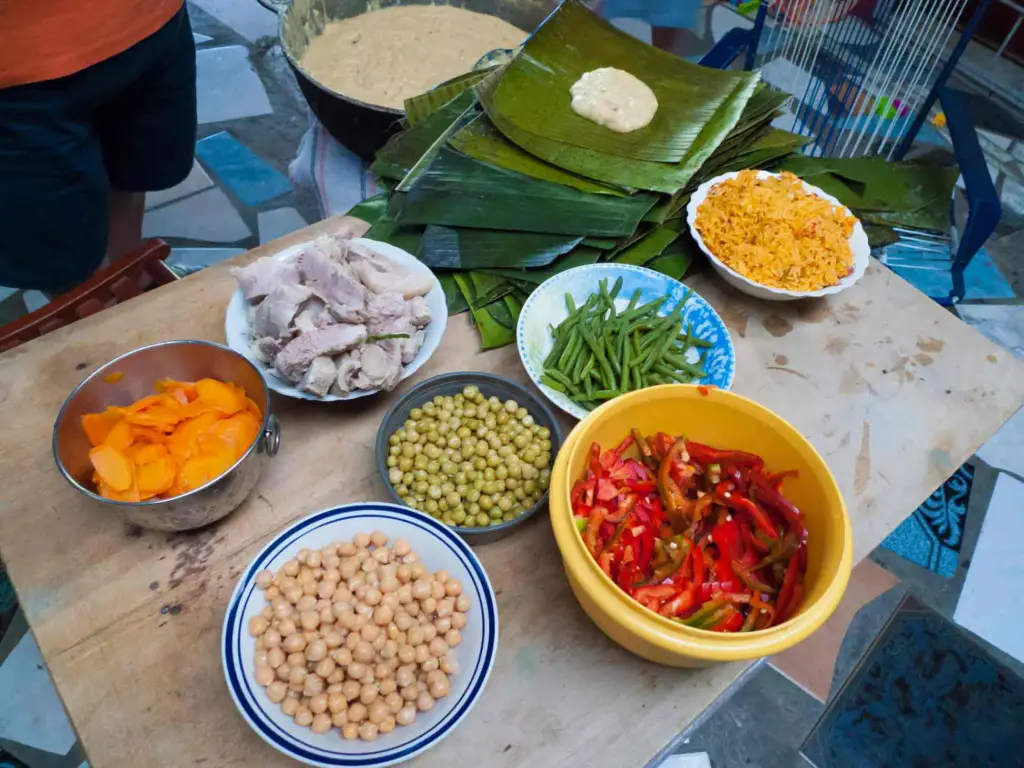
Costa Rican cuisine is a delightful fusion of flavors, influenced by its tropical climate, fertile soil, and cultural diversity. Let’s dive into the ingredients that make Costa Rican dishes so enticing:
1. Rice and Beans: The Heart of Tico Cooking
- Gallo Pinto: This iconic dish combines rice and black beans sautéed with onions, bell peppers, and a touch of Salsa Lizano (a tangy condiment). It’s a staple for breakfast and beyond.
- Casados: A complete meal featuring rice, beans, fried plantains, salad, and a choice of protein (chicken, fish, or beef). The name “casado” means “married man,” signifying a satisfying union of flavors.
2. Tropical Fruits and Vegetables
- Plantains: These starchy cousins of bananas are a culinary superstar. They can be fried into patacones (crispy plantain slices) or mashed into tostones.
- Yuca (Cassava): A root vegetable used in soups, stews, and as a side dish. Yuca fries are a popular street food.
- Pineapple: Costa Rica produces some of the world’s juiciest pineapples. Try them fresh or in refreshing juices.
- Mangoes: Bursting with sweetness, mangoes are enjoyed on their own or in salsas.
- Passion Fruit (Maracuyá): Tangy and aromatic, it’s used in desserts and beverages.
3. Fresh Seafood
- Corvina: A local sea bass, often grilled or fried.
- Ceviche: Fresh fish or shrimp marinated in lime juice, mixed with onions, cilantro, and peppers.
- Tuna: Costa Rica’s Pacific coast offers excellent tuna for sushi and sashimi.
4. Herbs and Spices
- Cilantro: Used generously in Costa Rican cooking, it adds freshness to dishes.
- Salsa Lizano: A beloved condiment with a unique blend of spices, perfect for gallo pinto.
- Achiote (Annatto): Gives a vibrant red color and mild flavor to rice and meats.
5. Dairy and Cheese
- Natilla: A thick, sweet custard made from milk and sugar.
- Queso Turrialba: A semi-hard cheese with a nutty flavor, great for snacking.
6. Coffee and Chocolate
- Coffee: Costa Rica produces some of the world’s finest Arabica coffee beans. Sip a cup of freshly brewed café chorreado.
- Cacao: Explore artisanal chocolate made from Costa Rican cacao beans.
Costa Rica’s ingredients reflect its biodiversity, cultural heritage, and love for simple, wholesome flavors. Whether you’re savoring gallo pinto by the beach or enjoying a cup of rich coffee in the mountains, each bite tells a story of this enchanting land.
References
Buen provecho! 🌴🍽️
Mastering Costa Rican Cuisine Cooking Techniques

From indigenous practices to colonial influences, the art of cooking in Costa Rica is deeply rooted in tradition. Let’s explore the techniques that bring these vibrant flavors to life:
1. Wood-Fired Cooking: Slow and Flavorful
- Wood-Fired Stoves: An outstanding feature of Costa Rican cuisine is the use of wood-fired stoves. These rustic ovens infuse dishes with a distinct smokiness and depth of flavor.
- Slow Cooking: Whether it’s simmering beans for gallo pinto or roasting meats, slow cooking over wood fires allows flavors to meld and intensify.
2. Grilling and Open Flames
- Traditional Grilling: Ticos (Costa Ricans) love grilling over open flames. Barbecued meats, such as churrasco (grilled steak) or pollo a la parrilla (grilled chicken), are staples.
- Salsa Lizano: A tangy condiment often brushed onto meats during grilling, adding a zesty kick.
3. Indigenous Techniques
- Grinding and Mashing: Indigenous tribes used traditional tools to grind corn for tortillas and tamale fillings. These techniques continue to influence Costa Rican cooking.
- Natural Herbs and Seasoning: Indigenous communities relied on natural herbs for flavoring, such as cilantro and achiote (annatto).
4. Slow Simmering and Stews
- Sancocho: This hearty stew features a medley of meats, root vegetables, and plantains. Slow simmering allows flavors to meld, creating a comforting dish.
- Rondon: A Caribbean coast specialty, rondon is a seafood stew cooked slowly with coconut milk, yucca, and aromatic spices.
5. Preservation Techniques
- Drying and Smoking: Indigenous tribes preserved meats and fish by drying and smoking them. Today, cecina (dried beef) and pescado seco (dried fish) are still enjoyed.
- Pickling: Ingredients like chayote (a green vegetable) are pickled to extend their shelf life.
6. Respect for Freshness
- Farm-to-Table: Costa Ricans prioritize fresh, local ingredients. Markets overflow with seasonal produce, and meals celebrate what’s in season.
- Seafood Straight from the Ocean: Coastal towns serve seafood caught that very day, ensuring maximum freshness.
Costa Rican cooking is an art form—a blend of ancient wisdom and contemporary flair. Whether it’s the crackle of wood fires or the slow simmering of stews, each technique adds depth and soul to the vibrant dishes of this enchanting land.
References
- Ultimate Guide to Authentic Costa Rican Cuisine
- Costa Rican Food, Cuisine and Gastronomy
- Traditional Costa Rica Cooking
Buen provecho! 🌴🔥🍽️.
Traditional Costa Rican Food

In this chapter, we explore five traditional dishes that encapsulate the essence of Costa Rican gastronomy, offering a delightful blend of flavors, textures, and cultural history.
1. Gallo Pinto: The Breakfast Anthem
Gallo Pinto, translating to “spotted rooster,” is the heart and soul of Costa Rican breakfasts. This iconic dish, a melange of rice, black beans, bell peppers, onions, and Lizano sauce, is a culinary tradition with roots dating back centuries. Its popularity extends beyond being a mere breakfast item; it’s a symbol of shared mornings, family unity, and a cultural identity.
2. Casado: A Marriage of Flavors
Casado, meaning “married man,” is a traditional lunchtime favorite that epitomizes the diversity of Costa Rican cuisine. This dish features a harmonious union of rice, black beans, plantains, a protein source (chicken, fish, or beef), and a fresh salad. Casado reflects the cultural diversity of Costa Rica, celebrating the marriage of flavors on a single plate.
3. Olla de Carne: A Hearty Tradition
Olla de Carne, a robust beef soup, traces its origins to Costa Rica’s agrarian past. Packed with beef, yams, corn, plantains, and a medley of vegetables, this hearty dish symbolizes familial warmth and shared meals. It is often enjoyed during festive occasions, bringing communities together.
4. Arroz con Pollo: A Flavorful Tradition
Arroz con Pollo, translating to “rice with chicken,” is a testament to Costa Rica’s fusion of flavors. This one-pot wonder combines rice, chicken, vegetables, and a medley of spices to create a dish that is both comforting and rich in cultural heritage. It showcases the influence of Spanish culinary traditions in Costa Rican cooking.
5. Sopa Negra: A Bean Lover’s Delight
Sopa Negra, or “black bean soup,” is a beloved dish that exemplifies the centrality of beans in Costa Rican cuisine. This simple yet flavorful soup combines black beans, vegetables, and a poached egg. Served with a side of rice, it showcases the versatility of beans and their significance in everyday Costa Rican meals.
Exploring Costa Rican Street Food

Beyond the trendy restaurants and upscale cafes, Costa Rica boasts a vibrant street food scene that pulsates with life and explodes with flavor. These open-air kitchens on wheels, or tucked away in bustling marketplaces, offer a delicious and affordable way to experience the true essence of Costa Rican cuisine.
A Culinary Adventure on Every Corner
Costa Rican street food is all about fresh, local ingredients and innovative cooking techniques. Vendors take pride in their craft, simmering stews in oversized pots, grilling meats over open flames, and expertly crafting fresh fruit concoctions.
The aroma of sizzling chorizo mingles with the sweetness of plantains frying, creating an irresistible symphony of scents that will have your stomach rumbling.
Street Food Gems to Tantalize Your Taste Buds
- Chorreadas: Imagine fluffy, golden corn pancakes, slightly thicker than their American counterparts. Chorreadas are a popular breakfast or snack option, often served with a dollop of sour cream and a sprinkle of cheese.
- Empanadas: A Latin American staple with a Costa Rican twist, these fried or baked pockets of dough come in a variety of savory fillings, from shredded chicken and seasoned beef to melty cheese and black beans.
- Patacones: Fried green plantains, twice-cooked to crispy perfection, are known as patacones. These versatile bites can be enjoyed plain with a sprinkle of salt or dressed up with cheese, sour cream, or even a dollop of guacamole.
- Elote: No street food scene is complete without grilled corn on the cob (elote). Costa Rican vendors take it up a notch, charring the corn over open flames and slathering it with a creamy mixture of mayonnaise, cheese, and a touch of chili powder.
- Pops: Cool down with a refreshing “pops,” Costa Rica’s answer to popsicles. These frozen treats come in a dazzling array of tropical fruit flavors, perfect for a hot afternoon.
Costa Rica’s Street Food Hubs
While you can find street food vendors throughout the country, some cities boast a particularly vibrant scene:
- San José: The bustling capital city offers a diverse range of street food options, from traditional fare to international influences. Head to Central Park or the Mercado Central for a taste explosion.
- Alajuela: This charming city, known as the Gateway to the Volcanoes, offers a delightful mix of traditional Costa Rican street food and innovative takes on classics.
- Jaco: A popular tourist destination, Jaco caters to a wider audience with its street food scene. Here, you’ll find familiar favorites alongside local specialties.
- Puerto Limón: The Afro-Caribbean influence shines brightly in Puerto Limon’s street food scene. Don’t miss specialties like “patí,” a savory turnover filled with meat and vegetables.
A Delicious and Affordable Adventure
Costa Rican street food offers a delicious and affordable way to experience the country’s vibrant culture and culinary heritage. So, grab a napkin, embrace the lively atmosphere, and embark on a delicious adventure through Costa Rica’s streets, one flavorful bite at a time!
The Most Popular the Costa Rican Recipes
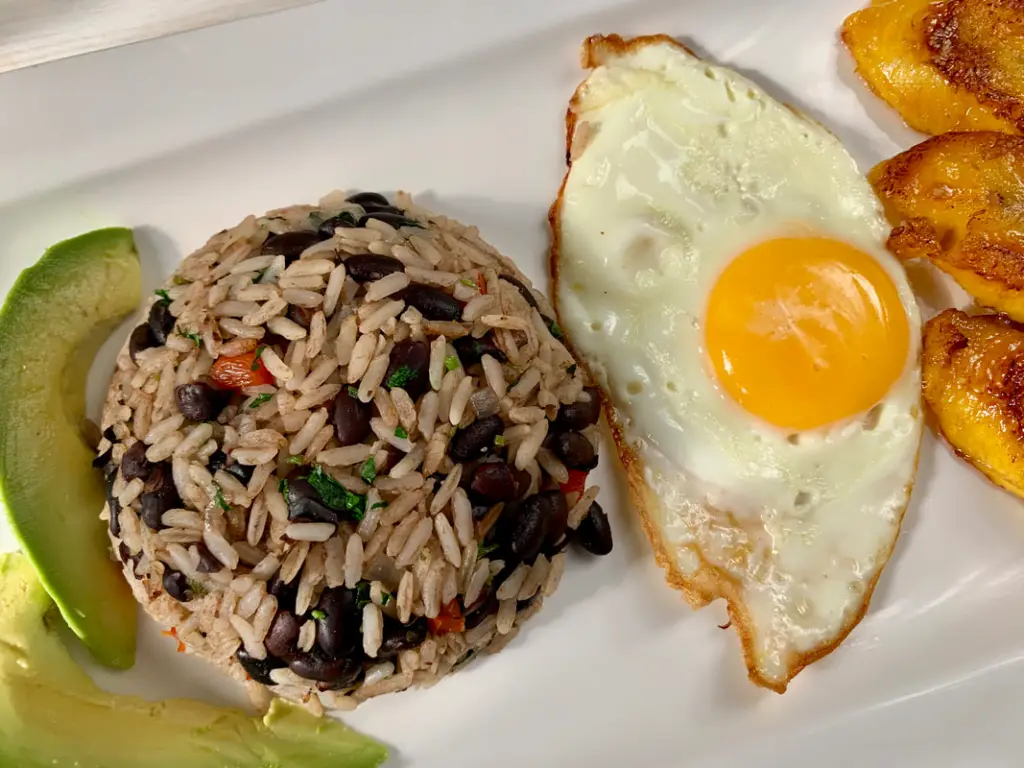
In this chapter, we embark on a culinary journey through ten of the most popular Costa Rican recipes, each offering a unique taste of this enchanting Central American nation.
Gallo Pinto: The National Breakfast Treasure
Gallo Pinto, meaning “spotted rooster,” is the heartbeat of Costa Rican mornings. This iconic breakfast dish combines rice, black beans, bell peppers, onions, and Lizano sauce, creating a savory symphony that kickstarts the day with a burst of energy and tradition.
Casado: The Marriage of Flavors on a Plate
Casado, translating to “married man,” is a beloved lunchtime delight. This well-balanced plate features rice, black beans, plantains, a protein source (chicken, fish, or beef), and a fresh salad. It symbolizes the harmonious union of diverse flavors and cultural influences.
Olla de Carne: Hearty Beef Soup for Celebrations
Olla de Carne, a robust beef soup, is a festive tradition in Costa Rican households. Packed with beef, yams, corn, plantains, and vegetables, this hearty dish is a celebration of warmth and communal dining, often enjoyed during special occasions.
Arroz con Pollo: A Flavorful Rice and Chicken Delight
Arroz con Pollo, or “rice with chicken,” is a flavorful one-pot wonder. This dish combines rice, chicken, vegetables, and spices, showcasing the Spanish culinary influence in Costa Rican cooking. It’s a comforting meal with a touch of cultural flair.
Sopa Negra: The Bean Lover’s Soup
Sopa Negra, or “black bean soup,” is a beloved bean-centric dish. Combining black beans, vegetables, and a poached egg, this simple yet hearty soup exemplifies the versatility of beans in Costa Rican cuisine.
Picadillo de Papa: Savory Potato Hash
Picadillo de Papa is a savory potato hash that highlights Costa Rica’s love for potatoes. Potatoes are sautéed with onions, bell peppers, and spices, creating a flavorful side dish or a standalone meal when accompanied by rice.
Ceviche: Fresh and Zesty Seafood Dish
Ceviche, a refreshing seafood dish, showcases Costa Rica’s coastal abundance. Fish or shrimp is marinated in lime juice, mixed with tomatoes, onions, cilantro, and peppers, creating a zesty and citrusy delight.
Tamal de Cerdo: Pork Tamales for Festive Occasions
Tamal de Cerdo, or pork tamales, are a festive treat often enjoyed during holidays and special events. Corn masa is filled with seasoned pork, wrapped in banana leaves, and steamed to perfection, creating a savory and aromatic dish.
Yuca con Mojo: Cassava with Garlic Sauce
Yuca con Mojo features cassava, a starchy root vegetable, served with a flavorful garlic sauce. Boiled yuca is drizzled with mojo, a sauce made with garlic, citrus, and spices, creating a simple yet delicious side dish.
Tres Leches Cake: Sweet Culinary Finale
Tres Leches Cake, the sweet finale to many Costa Rican meals, is a sponge cake soaked in a three-milk mixture (condensed milk, evaporated milk, and heavy cream). Topped with whipped cream, it’s a decadent and moist dessert that satisfies any sweet tooth.
What are the Health Implications of Costa Rican Cuisine?
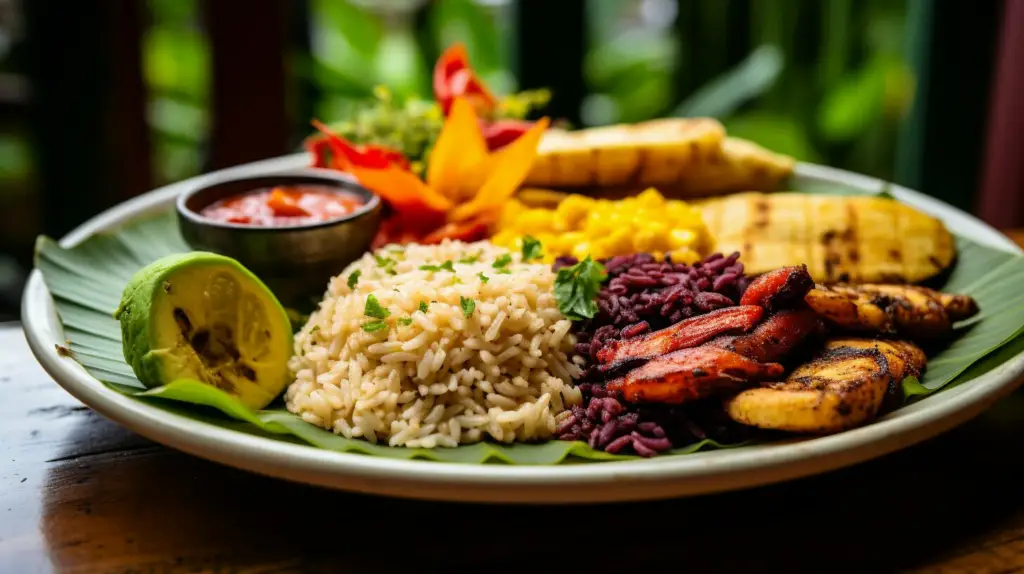
Costa Rica isn’t just a paradise for the eyes; it’s a haven for your health too! Beyond the stunning rainforests and pristine beaches lies a culinary tradition that tantalizes taste buds and nourishes your body.
Let’s delve into the reasons why Costa Rican food is a recipe for well-being, and explore some health considerations for the country’s population.
A Rainbow on Your Plate: Fresh Produce Power
One bite of a Costa Rican dish is an explosion of fresh, vibrant flavors. Local fruits and vegetables are the stars of the show, boasting a wealth of health benefits. Imagine juicy pineapples and mangoes bursting with Vitamin C and digestive enzymes, perfectly complementing the earthy goodness of yuca and plantains, rich sources of complex carbohydrates and fiber.
These ingredients, harvested at their peak, are nature’s powerhouses, packed with antioxidants, vitamins, and minerals to keep you feeling your best.
The Heart of the Matter: Beans and Rice
The foundation of Costa Rican cuisine is a heart-healthy duo: beans and rice. These nutritional powerhouses are packed with fiber and plant-based protein, working together to lower cholesterol levels and keep your heart happy.
The high fiber content keeps your digestion running smoothly and regulates blood sugar, while the low-fat profile makes them ideal for a healthy heart.
Lean and Mean Protein Power
Costa Rican cuisine champions lean proteins like fish and chicken, often prepared using health-conscious methods like grilling or baking. These protein sources are lower in fat and calories, making them perfect for building and repairing muscle, keeping you strong and energized throughout the day.
Light on Calories, Big on Flavor
Compared to many Western cuisines, Costa Rican dishes tend to have a lower calorie count. This is thanks to the emphasis on fresh, unprocessed ingredients and simple cooking techniques. You can enjoy delicious food without compromising your waistline.
Cooking with Care: Traditional Techniques
Traditional Costa Rican cooking methods deserve a shout-out! Techniques like grilling and boiling preserve the natural flavors and nutrients of the ingredients, ensuring you get the full health benefits with every bite.
A Look at Population Health: Balancing Tradition with Modern Challenges
While Costa Rican cuisine offers a path to wellness, there are some health considerations to keep in mind. Like many Latin American countries, Costa Rica is experiencing a rapidly aging population.
This has led to an increase in diabetes, impacting both individuals and the healthcare system. The number of elderly individuals with diabetes is projected to double in just over a decade, highlighting the need for preventative measures.
Cardiovascular disease is another significant health concern in Costa Rica, accounting for around 30% of all deaths. Risk factors like smoking, high blood pressure, high cholesterol, and physical inactivity require ongoing attention. Obesity is also a concern, contributing to diabetes, stomach cancer, and cervical cancer.
References
- The Health Benefits of Costa Rican Cuisine
- Projected impact of diabetes on the Costa Rican healthcare system
- Costa Rica – Health Issues
- Association between obesity and mortality in the Costa Rican elderly
Costa Rica’s National Dish

In the heart of Costa Rica’s culinary landscape stands a dish that embodies the nation’s spirit and cultural identity – Gallo Pinto. More than just a plate of rice and beans, Gallo Pinto is a culinary phenomenon, a daily ritual, and an expression of the vibrant tapestry that is Costa Rican cuisine.
A Morning Symphony: Gallo Pinto at Breakfast
Gallo Pinto’s roots can be traced back to the indigenous tribes of Costa Rica, who cultivated rice and beans as staples. Over the centuries, the dish evolved with the arrival of Spanish settlers, who introduced new cooking techniques and spices.
Today, Gallo Pinto stands as a testament to the fusion of indigenous and European influences that shape the country’s gastronomic heritage.
Ingredients and Preparation
At its core, Gallo Pinto is a harmonious blend of rice, black beans, bell peppers, onions, and the quintessential Lizano sauce. This savory concoction is pan-fried to perfection, infusing every grain of rice with the earthy aroma of beans and the subtle kick of Lizano.
It’s a dish that transcends simplicity, delivering a symphony of flavors on the palate.
Costa Rican Cuisine – Great Recipes to Try at Home
The cuisine offers a variety of dishes that you can easily prepare at home, allowing you to savor the flavors of this beautiful country.
Whether you’re a fan of starters, main courses, or puddings, there’s something for everyone to enjoy.
Costa Rica Food – Pork Cracklings

A Culinary Journey Through Tradition and Flavor
Embark on a flavorsome expedition with one of Costa Rica’s iconic delights – Pork Cracklings. Rooted in the nation’s rich culinary heritage, this crispy delicacy is a celebration of local traditions and the artistry of transforming simple ingredients into a tantalizing treat.
Originating from the heart of Central America, Pork Cracklings have become a beloved snack, cherished for their crunch and savory appeal.
Costa Rica Food – Pork Cracklings – Ingredients to Craft the Perfect Crunch
- 2 pounds pork skin, cleaned and fat removed
- 1 tablespoon salt
- 1 teaspoon black pepper
- 1 teaspoon garlic powder
- 1 teaspoon paprika
- 1 cup vegetable oil (for frying)
Costa Rica Food – Pork Cracklings – Crafting the Crispy Magic: A Step-by-Step Recipe
1. Prepare the Pork Skin
- Cut the cleaned pork skin into bite-sized pieces, ensuring they are dry.
2. Season the Pork Skin
- In a bowl, mix salt, black pepper, garlic powder, and paprika.
- Sprinkle the seasoning mix evenly over the pork skin, ensuring each piece is coated.
3. Let it Marinate
- Allow the seasoned pork skin to marinate for at least 30 minutes. This enhances the flavors and ensures a delicious crunch.
4. Heat the Vegetable Oil
- In a deep pan, heat the vegetable oil over medium-high heat until it reaches around 350°F (180°C).
5. Fry to Golden Perfection
- Carefully add the marinated pork skin to the hot oil in small batches.
- Fry until the pieces turn golden brown and become crispy. This usually takes about 5-7 minutes.
6. Drain and Season
- Once crispy, remove the pork cracklings from the oil and place them on paper towels to drain excess oil.
- While still hot, season with an additional sprinkle of salt for an extra burst of flavor.
7. Serve and Enjoy
- Serve your homemade Pork Cracklings as a snack or appetizer. Pair them with your favorite dipping sauce or enjoy them as they are!
### Serving Information
- Serves: 6-8 people
- Estimated Cooking Time: 45 minutes
- Nutritional Information (per serving):
- Calories: 200
- Protein: 10g
- Fat: 15g
- Carbohydrates: 2g
- Fiber: 0g
- Sugar: 0g
Pork Cracklings in Costa Rica aren’t just a snack; they’re a culinary adventure, a crispy testament to the country’s love for simple, delicious pleasures. So, grab a bite and savor the crunch that echoes the traditions of this beautiful Central American nation!
Costa Rican Food – Chifrijo

Discovering Costa Rican Delight: Chifrijo Fiesta
Hello, fellow food enthusiasts! Today, we’re embarking on a culinary journey into the heart of Costa Rican street food with a delicious dish called Chifrijo. As a traveler and restaurant owner, I’m thrilled to delve into the history, cultural roots, and guide you through creating this savory delight in your own kitchen.
History and Background
Chifrijo is a modern star in Costa Rican cuisine, emerging from the vibrant street food scene. This fusion dish beautifully combines elements from local and international culinary influences.
Originating in the San Jose region, Chifrijo gained popularity for its bold flavors and became a beloved appetizer and snack across the country. Its name is a playful blend of “chicharrón” (fried pork) and “arroz” (rice), highlighting its main ingredients.
Costa Rican Food – Chifrijo Ingredients
Embark on your Chifrijo Fiesta with these ingredients for approximately 4 servings:
- 2 cups cooked white rice
- 1 cup black beans, cooked and drained
- 1 cup pork chicharrón, fried and crispy
- 1 cup pico de gallo (tomatoes, onions, cilantro, lime juice)
- 1/2 cup guacamole
- 1/2 cup Lizano sauce (or substitute with Worcestershire sauce)
- Fresh cilantro for garnish
- Salt and pepper to taste
- Tortilla chips for serving
Costa Rican Food – Chifrijo Recipe
1. Prepare the Components
- Cook Rice: Prepare 2 cups of white rice according to package instructions.
- Fry Chicharrón: Fry pork chicharrón until crispy. Drain excess oil on paper towels.
- Create Pico de Gallo: Mix diced tomatoes, onions, cilantro, and lime juice to make pico de gallo.
- Guacamole Magic: Mash ripe avocados and mix with salt, pepper, and lime juice to create guacamole.
2. Assemble the Chifrijo
- Layering Magic: In serving bowls, layer cooked white rice, black beans, crispy chicharrón, pico de gallo, and guacamole.
- Drizzle Lizano Sauce: Add a generous drizzle of Lizano sauce (or Worcestershire sauce) for that authentic Costa Rican touch.
3. Garnish and Serve
- Fresh Cilantro: Garnish with fresh cilantro for a burst of color and flavor.
- Serve with Chips: Accompany your Chifrijo with tortilla chips for that extra crunch.
This Chifrijo recipe serves approximately 4 people, making it a fantastic appetizer or sharing dish.
Estimated Cooking Time: 30 minutes
Nutritional Information (per serving):
- Calories: 400
- Protein: 10g
- Fat: 20g
- Carbohydrates: 50g
- Fiber: 8g
Bring the vibrant flavors of Costa Rican Street food into your home with this delightful Chifrijo Fiesta. ¡Buen provecho!
Costa Rica Food – Tripe Soup (Mondongo)

History, Background, and Region: A Taste of Costa Rican Tradition
Costa Rican cuisine is a harmonious blend of indigenous, Spanish, and African influences, reflecting the nation’s rich cultural tapestry. One dish that encapsulates this culinary diversity is Mondongo, a hearty tripe soup.
Originating from the central region of Costa Rica, Mondongo has deep roots in the country’s history. This dish has been passed down through generations, evolving into a beloved comfort food that brings people together.
Ingredients: A Symphony of Flavors
- 1 pound beef tripe, cleaned and cut into small pieces
- 1 pound beef honeycomb tripe, cleaned and chopped
- 1 cup diced chorizo
- 1 cup diced pork belly
- 1 cup diced onions
- 1 cup diced bell peppers (red and green)
- 1 cup diced carrots
- 1 cup diced celery
- 4 cloves garlic, minced
- 1 cup tomato sauce
- 1 cup chopped tomatoes
- 1 cup cooked hominy corn
- 1 teaspoon dried oregano
- 1 teaspoon ground cumin
- 1 teaspoon paprika
- Salt and pepper to taste
- 8 cups beef broth
- 2 bay leaves
- Fresh cilantro for garnish
- Lime wedges for serving
Recipe: A Culinary Symphony for 6 Servings
Preparation of Ingredient
- Clean the Tripe: Rinse the beef tripe thoroughly, ensuring it’s free of any impurities. Cut it into small, bite-sized pieces.
- Prepare Vegetables: Dice onions, bell peppers, carrots, and celery. Mince garlic. Chop tomatoes and set aside.
- Cook the Hominy: If using dried hominy, cook it according to package instructions. Drain and set aside.
Cooking Instructions
- Sauté Aromatics: In a large pot, heat some oil over medium heat. Sauté onions, bell peppers, carrots, celery, and garlic until fragrant.
- Add Meat and Chorizo: Introduce diced chorizo, pork belly, beef tripe, and honeycomb tripe to the pot. Cook until the meat is browned.
- Season and Simmer: Stir in tomato sauce, chopped tomatoes, oregano, cumin, paprika, salt, and pepper. Pour in the beef broth and add bay leaves. Bring the mixture to a boil, then reduce the heat and simmer for 2 hours until the tripe is tender.
- Incorporate Hominy: Add the cooked hominy corn to the pot, allowing it to simmer for an additional 30 minutes.
- Serve Hot: Remove bay leaves and ladle the steaming Mondongo into bowls. Garnish with fresh cilantro and serve with lime wedges.
Estimated Cooking Time: 2.5 hours
Nutritional Information (Per Serving):
- Calories: 400
- Protein: 20g
- Carbohydrates: 30g
- Fat: 23g
- Fiber: 5g
Experience the Heart and Soul of Costa Rican Cuisine with Mondongo!
Costa Rica Food – Chorreadas

A Culinary Tale from the Tropics
Costa Rica’s gastronomy is a captivating blend of flavors, and one dish that stands out is the beloved Chorreadas. Originating from the Central Valley region, Chorreadas are corn pancakes infused with local charm and tradition.
This dish pays homage to the fertile lands and cornfields that have sustained Costa Ricans for generations.
Chorreadas Recipe: A Symphony of Corn and Culture
Costa Rica Food – Chorreadas Ingredients (Serves 4):
- 2 cups fresh corn kernels
- 1 cup all-purpose flour
- 1 cup milk
- 2 eggs
- 2 tablespoons sugar
- 1 teaspoon baking powder
- 1/2 teaspoon salt
- Butter or oil for cooking
- Maple syrup or honey (for serving)
Costa Rica Food – Chorreadas Recipe:
Preparing Ingredients:
- Prepare Corn Mixture (Serves 4):
- In a blender, combine fresh corn kernels, milk, and eggs.
- Blend until you achieve a smooth consistency.
- Combine Dry Ingredients (Serves 4):
- In a mixing bowl, whisk together flour, sugar, baking powder, and salt.
Cooking Chorreadas:
- Mix Batter (Serves 4):
- Gradually add the corn mixture to the dry ingredients, stirring until well combined.
- Cooking Chorreadas (Serves 4):
- Heat a skillet or griddle over medium heat and add butter or oil.
- Pour 1/4 cup of batter onto the hot surface for each Chorreada.
- Cook until bubbles form on the surface, then flip and cook the other side until golden brown.
- Serve and Enjoy (Serves 4):
- Stack the Chorreadas on a plate and drizzle with maple syrup or honey.
Chorreadas Delight: Sharing Costa Rican Joy
This delightful Chorreadas recipe serves 4, making it a perfect treat for a family breakfast or brunch with friends. The estimated cooking time is around 20 minutes, allowing you to savor the flavors of Costa Rica without spending hours in the kitchen.
Embrace the simplicity and warmth of this Central Valley classic, and bring a touch of Pura Vida to your home.
Nutritional Information (Per Serving):
- Calories: 250
- Protein: 8g
- Carbohydrates: 40g
- Fat: 6g
- Fiber: 3g
- Sodium: 300mg
Costa Rica Food – Tamal De Maicena

Embracing Tradition: Costa Rican Tamal De Maicena
Hey there, food explorers! Today, let’s dive into the heart of Costa Rican heritage with a classic dish – Tamal De Maicena. As a traveler and small restaurant owner, I’m excited to unravel the history, cultural roots, and guide you through crafting these delightful cornstarch tamales in your own kitchen.
History and Background
Tamal De Maicena holds a special place in Costa Rican culinary traditions. Originating from indigenous influences and evolving with the Spanish colonization, this tamale variation reflects the fusion of native ingredients and European techniques.
Often enjoyed during festivals and family gatherings, Tamal De Maicena showcases the country’s commitment to preserving traditional flavors.
Costa Rica Food – Tamal De Maicena Ingredients
Embark on your Tamal De Maicena adventure with these ingredients for approximately 12 tamales:
- 2 cups cornstarch (maicena)
- 1 cup sugar
- 1 cup butter, softened
- 1 cup milk
- 1 teaspoon baking powder
- 1/2 teaspoon salt
- 1 teaspoon vanilla extract
- Banana leaves or corn husks for wrapping
Costa Rica Food – Tamal De Maicena Recipe
1. Prepare the Maicena Dough
- Mix Dry Ingredients: In a bowl, combine cornstarch, sugar, baking powder, and salt.
- Incorporate Wet Ingredients: Add softened butter, milk, and vanilla extract. Mix until a smooth and consistent dough forms.
2. Prepare Banana Leaves or Corn Husks
- Soften Wrappers: If using banana leaves, soften them by passing over an open flame or soaking them in hot water. For corn husks, soak them in warm water until pliable.
3. Assemble the Tamales
- Spread Dough: Place a portion of the maicena dough onto the center of a banana leaf or corn husk.
- Fold and Seal: Fold the sides of the wrapper over the dough, creating a rectangular package. Secure the edges.
4. Steam to Perfection
- Prepare Steamer: Arrange the tamales upright in a steamer.
- Steam Tamales: Steam for approximately 1.5 to 2 hours, or until the maicena is firm and cooked through.
5. Serve and Enjoy
- Cool and Unwrap: Allow the tamales to cool slightly before unwrapping. Serve warm and enjoy the sweet, comforting flavors.
This Tamal De Maicena recipe serves approximately 6 people, making it a delightful treat for sharing or enjoying over multiple occasions.
Estimated Cooking Time: 2.5 hours
Nutritional Information (per tamale):
- Calories: 250
- Protein: 2g
- Fat: 10g
- Carbohydrates: 40g
- Fiber: 1g
Immerse yourself in the taste of Costa Rican tradition with these Tamal De Maicena. ¡Buen provecho!
Costa Rica Food – Rondon

As a passionate traveler and restaurant owner, I’m always on the lookout for unique recipes that capture the essence of a region. Today, we embark on a culinary journey to Costa Rica to savor the delightful flavors of Rondon—a Caribbean-inspired dish that brings together the richness of seafood and the tropical goodness of coconut.
History and Background
Rondon is a beloved dish in Caribbean cuisine, and its roots trace back to the coastal communities of Belize, Honduras, and other Caribbean countries. Originating from the Afro-Caribbean culture, Rondon reflects a fusion of local ingredients and culinary traditions.
The dish has become a symbol of communal gatherings and celebration, with its aromatic blend of seafood, coconut, and island spices.
Costa Rica Food – Rondon Ingredients
Prepare to immerse yourself in the vibrant flavors of Rondon with this carefully curated list of ingredients:
- 1 lb fish fillets (snapper or grouper)
- 1/2 lb shrimp, peeled and deveined
- 1/2 lb crab meat
- 2 cups coconut milk
- 2 green plantains, sliced
- 1 sweet potato, diced
- 2 yams, cubed
- 2 green bell peppers, chopped
- 1 onion, finely diced
- 3 cloves garlic, minced
- 1 Scotch bonnet pepper, seeds removed and minced
- 2 tablespoons fresh thyme leaves
- 2 tablespoons vegetable oil
- Salt and pepper to taste
Costa Rica Food – Rondon Recipe
1. Prepare the Ingredients
- Clean the seafood: Rinse the fish fillets, shrimp, and crab meat under cold water. Pat them dry with a paper towel.
- Slice and dice: Prepare the plantains, sweet potato, yams, green bell peppers, onion, and Scotch bonnet pepper as per the ingredient list.
2. Start Cooking
- Sauté the aromatics: In a large pot, heat vegetable oil over medium heat. Sauté garlic, onion, and Scotch bonnet pepper until fragrant.
- Add coconut milk: Pour in the coconut milk, bringing it to a gentle simmer.
3. Layer the Ingredients
- Layer the vegetables: Add the sliced plantains, diced sweet potato, cubed yams, and chopped green bell peppers to the pot.
- Season and simmer: Season with salt, pepper, and fresh thyme. Let the vegetables simmer until slightly tender.
4. Introduce the Seafood
- Incorporate seafood: Place the fish fillets, shrimp, and crab meat into the pot. Allow them to cook gently until the seafood is fully cooked.
5. Serve and Enjoy
- Serve hot: Ladle the Rondon into bowls, ensuring a generous mix of seafood, vegetables, and flavorful broth.
- Garnish as desired: Consider adding fresh herbs or a squeeze of lime for an extra burst of flavor.
Serve this delectable Rondon to approximately 4 people, and savor the taste of the Caribbean right in your own kitchen!
Estimated Cooking Time: 45 minutes
Nutritional Information (per serving):
- Calories: 400
- Protein: 25g
- Fat: 20g
- Carbohydrates: 30g
- Fiber: 5g
Embark on this culinary adventure and let the flavors of Rondon transport you to the sun-kissed shores of Costa Rica.
Costa Rica Food – Sopa Negra

Hey, fellow food enthusiasts! Today, we’re diving into the heart of Costa Rican cuisine with a classic dish called Sopa Negra. As a globe-trotting food blogger and a restaurant owner, I can’t wait to share the rich history and flavors of this comforting black bean soup that originates from the beautiful region of Costa Rica.
History and Background
Sopa Negra, which translates to “Black Soup,” is a traditional Costa Rican dish known for its deep, savory flavors and cultural significance. Originating from the rural areas of Costa Rica, this hearty soup has its roots in the country’s farming communities.
The star ingredient, black beans, holds historical importance as a staple in the Costa Rican diet, dating back to indigenous cultures.
Costa Rica Food – Sopa Negra Ingredients
Let’s gather the ingredients for a delightful bowl of Sopa Negra:
- 2 cups black beans, cooked
- 1 onion, finely chopped
- 2 cloves garlic, minced
- 1 red bell pepper, diced
- 1 carrot, sliced
- 2 tomatoes, chopped
- 1 cup cabbage, shredded
- 1 cup spinach, chopped
- 1 cup cilantro, chopped
- 1 teaspoon cumin
- 1 teaspoon oregano
- 4 cups vegetable broth
- 2 tablespoons vegetable oil
- Salt and pepper to taste
Costa Rica Food – Sopa Negra Recipe
1. Prepare the Ingredients
- Cook the black beans: If not pre-cooked, simmer black beans until tender. Drain and set aside.
- Chop and dice: Prepare the onion, garlic, red bell pepper, carrot, tomatoes, cabbage, spinach, and cilantro as per the ingredient list.
2. Sauté and Spice
- Sauté aromatics: In a large pot, heat vegetable oil over medium heat. Sauté onion and garlic until softened.
- Add spices: Stir in cumin and oregano, allowing the spices to release their flavors.
3. Build the Soup Base
- Add vegetables: Toss in red bell pepper, carrot, tomatoes, cabbage, and spinach. Cook until vegetables are slightly tender.
- Introduce black beans: Incorporate the cooked black beans into the pot, mixing them well with the vegetables.
4. Simmer to Perfection
- Pour in broth: Add vegetable broth to the pot, ensuring it covers the ingredients. Bring the soup to a gentle simmer.
- Season and simmer: Season with salt and pepper, allowing the soup to simmer for at least 20-25 minutes to meld the flavors.
5. Serve and Enjoy
- Garnish and serve: Ladle the hot Sopa Negra into bowls and garnish with fresh cilantro. Serve with a wedge of lime for an extra zing.
This wholesome Sopa Negra recipe serves approximately 4 people, making it perfect for a family dinner or sharing with friends.
Estimated Cooking Time: 45 minutes
Nutritional Information (per serving):
- Calories: 250
- Protein: 10g
- Fat: 8g
- Carbohydrates: 40g
- Fiber: 12g
Immerse yourself in the warmth and flavors of Costa Rica with this authentic Sopa Negra. Buen provecho!
Costa Rica Food – Empanadas

Embarking on a Flavorful Journey: Costa Rican Empanadas
Hey, foodies! Join me on a culinary adventure as we explore the taste of Costa Rica through a beloved dish – Empanadas. As a travel enthusiast and small restaurant owner, I’m excited to share the history, unique flavors, and easy steps to recreate these delightful pockets of goodness at home.
History and Background
Costa Rican Empanadas have a special place in the country’s culinary heritage. Originating from Spanish influence, empanadas made their way into Costa Rica and quickly became a popular snack or street food. These savory pastries boast a delightful mix of local and international flavors, reflecting the diverse cultural influences that shape Costa Rican cuisine.
Costa Rica Food – Empanadas Ingredients
Let’s gather the ingredients for approximately 10 delicious Costa Rican Empanadas:
- 2 cups all-purpose flour
- 1/2 cup cornmeal
- 1/2 cup unsalted butter, cold and diced
- 1/2 cup warm water
- 1 teaspoon salt
- 1 cup ground beef or chicken (cooked and seasoned)
- 1 cup black beans, cooked and mashed
- 1 cup cheese, shredded
- 1/2 cup bell peppers, finely chopped
- 1/4 cup onion, finely chopped
- 2 cloves garlic, minced
- 1 teaspoon cumin
- 1 teaspoon paprika
- 1/2 teaspoon chili powder
- Cooking oil for frying
Costa Rica Food – Empanadas Recipe
1. Prepare the Dough
- Combine dry ingredients: In a bowl, mix flour, cornmeal, and salt.
- Incorporate butter: Add cold, diced butter to the dry mixture, rubbing it in until it resembles breadcrumbs.
- Add water: Gradually add warm water, kneading the dough until it comes together. Wrap in plastic and chill for 30 minutes.
2. Make the Filling
- Cook meat: In a pan, cook ground beef or chicken with cumin, paprika, and chili powder until browned.
- Sauté vegetables: In the same pan, sauté onions, garlic, and bell peppers until softened. Mix in cooked meat, black beans, and cheese.
3. Assemble Empanadas
- Roll out dough: Divide the chilled dough into golf ball-sized portions. Roll each into a circle, about 6 inches in diameter.
- Add filling: Spoon a generous amount of the filling onto one half of each dough circle.
- Seal and crimp: Fold the other half over the filling, creating a half-moon shape. Press and crimp the edges with a fork to seal.
4. Fry to Golden Perfection
- Heat oil: In a deep pan, heat cooking oil to 350°F (180°C).
- Fry empanadas: Carefully place empanadas into the hot oil, frying until golden brown on both sides. Remove and drain excess oil on paper towels.
5. Serve and Enjoy
- Cool and devour: Allow empanadas to cool slightly before serving. Enjoy these golden delights as a snack, appetizer, or even a meal!
This Empanadas recipe serves approximately 4 people, making it a perfect treat for family gatherings or casual get-togethers.
Estimated Cooking Time: 1 hour
Nutritional Information (per empanada):
- Calories: 250
- Protein: 8g
- Fat: 12g
- Carbohydrates: 30g
- Fiber: 3g
Bring the taste of Costa Rica into your kitchen with these homemade Empanadas. ¡Buen provecho!
Costa Rica Food – Patacones

Delightful Costa Rican Bites: Patacones Adventure
Hello, fellow food explorers! Today, we’re diving into the heart of Costa Rican cuisine with a crispy and savory treat called Patacones. As a passionate traveler and a restaurant owner, I’m thrilled to share the history, regional vibes, and an easy guide to crafting these golden delights in your own kitchen.
History and Background
Patacones, also known as Tostones in some regions, have deep roots in Latin American and Caribbean cuisines. Originating from Afro-Caribbean culinary traditions, these twice-fried green plantains are a beloved snack across Costa Rica.
The dish perfectly captures the essence of the country’s tropical abundance and cultural diversity.
Costa Rica Food – Patacones Ingredients
Let’s gather the simple yet flavorful ingredients to make approximately 20 Patacones:
- 4 green plantains, peeled and sliced
- Vegetable oil for frying
- Salt
- Optional toppings: Guacamole, black beans, cheese, or pico de gallo for serving.
Costa Rica Food – Patacones Recipe
1. Prepare the Plantains
- Choose green plantains: Opt for firm, green plantains. Peel and cut them into 1-inch thick rounds.
- Heat oil: In a deep pan, heat enough vegetable oil for frying over medium-high heat.
2. First Fry
- Fry plantains: Carefully add plantain slices to the hot oil. Fry for about 2-3 minutes per side or until they become lightly golden.
- Remove and flatten: Take the partially fried plantains out and place them on a flat surface. Use a flat surface (like a plate or a plantain press) to gently flatten each slice.
3. Second Fry
- Reheat oil: Return the flattened plantains to the hot oil and fry for an additional 2-3 minutes per side until they achieve a crispy, golden texture.
- Drain and season: Once golden brown, remove the Patacones and place them on paper towels to drain excess oil. Sprinkle with salt while they are still warm.
4. Serve and Enjoy
- Optional toppings: Serve Patacones with optional toppings like guacamole, black beans, cheese, or pico de gallo.
- Enjoy immediately: Patacones are best enjoyed fresh and warm!
This Patacones recipe serves approximately 4 people, making it a delightful appetizer or snack for sharing.
Estimated Cooking Time: 30 minutes
Nutritional Information (per serving – 5 Patacones):
- Calories: 150
- Protein: 1g
- Fat: 8g
- Carbohydrates: 20g
- Fiber: 1g
Bring a taste of Costa Rica into your home with these crunchy Patacones. Get ready for a flavor-packed journey!
Costa Rican Food – Elote

Savoring Costa Rica’s Corn Delight: Elote Extravaganza
Hey, foodie adventurers! Today, let’s dive into the vibrant flavors of Costa Rica with a street food classic – Elote. As a wanderer and a restaurant owner, I’m thrilled to share the history, cultural vibes, and a step-by-step guide to crafting this delicious corn treat at home.
History and Background
Elote has deep roots in Latin American street food culture, and in Costa Rica, it’s a beloved snack that encapsulates the essence of local flavors. Originating from indigenous traditions, elote showcases the rich agricultural heritage of the region, where corn holds cultural significance. The combination of sweet corn, savory toppings, and a burst of lime reflects the diverse and vibrant culinary landscape of Costa Rica.
Costa Rican Food – Elote Ingredients
Gather these simple ingredients to make approximately 4 servings of tasty Elote:
- 4 ears of fresh corn, husked
- 1/2 cup mayonnaise
- 1/2 cup cotija cheese, crumbled
- 1 teaspoon chili powder (adjust to taste)
- 1 lime, cut into wedges
- Fresh cilantro, chopped (optional)
- Salt and pepper to taste
Costa Rican Food – Elote Recipe
1. Prepare the Corn
- Boil or Grill Corn: Cook the corn by boiling or grilling until tender. Remove from heat.
2. Dressing and Coating
- Mayonnaise Magic: Spread a thin layer of mayonnaise over each ear of corn, ensuring an even coating.
- Cheese Fiesta: Sprinkle crumbled cotija cheese generously over the mayo-covered corn.
- Chili Powder Splash: Dust each ear with chili powder for a spicy kick. Adjust to your preferred level of heat.
- Season with Salt and Pepper: Add a pinch of salt and pepper to taste.
3. Serve and Garnish
- Presentation Time: Place the elote on a serving plate or individual holders.
- Cilantro Sparkle (Optional): If you like, sprinkle chopped fresh cilantro for a burst of herbaceous flavor.
- Lime Wedge Squeeze: Serve with lime wedges on the side, allowing each person to add a zesty touch.
4. Enjoy the Flavor Fiesta
- Dig In: Grab a hold of the elote and savor the delicious combination of sweet corn, creamy mayo, tangy cheese, and a hint of spice.
This Elote recipe serves approximately 4 people, making it a delightful snack or side dish for a small gathering.
Estimated Cooking Time: 20 minutes
Nutritional Information (per serving):
- Calories: 250
- Protein: 7g
- Fat: 15g
- Carbohydrates: 30g
- Fiber: 4g
Bring the street food vibes of Costa Rica into your home with this easy and flavorful Elote recipe. ¡Buen provecho!
Costa Rican Food – Patí

Exploring Costa Rican Delicacies: Patí Perfection
Hello, fellow food enthusiasts! Today, we’re venturing into the heart of Costa Rican cuisine with a dish deeply rooted in tradition – Patí. As a passionate traveler and a restaurant owner, I’m excited to unravel the history, cultural significance, and guide you through creating this savory pastry in your own kitchen.
History and Background
Patí holds a special place in the culinary tapestry of Costa Rica. Originating from Afro-Caribbean influences, this flavorful hand pie has become a staple in the country’s cuisine. With a history dating back to the times of Jamaican immigrants settling in Costa Rica, Patí seamlessly blends local ingredients and spices, creating a mouthwatering treat that reflects the cultural diversity of the region.
Costa Rican Food – Patí Ingredients
Embark on your Patí journey by gathering these ingredients.
- 2 cups all-purpose flour
- 1 cup unsalted butter, cold and cubed
- 1/2 cup cold water
- 1 teaspoon salt
Filling:
- 1 lb ground beef
- 1 onion, finely chopped
- 2 cloves garlic, minced
- 1 bell pepper, diced
- 1 tomato, chopped
- 1 teaspoon ground cumin
- 1 teaspoon dried oregano
- 1/2 teaspoon chili powder
- Salt and pepper to taste
- Cooking oil for sautéing
Costa Rican Food – Patí Recipe
1. Prepare the Dough
- Combine Ingredients: In a bowl, mix the flour and salt. Add the cold, cubed butter and incorporate until it resembles coarse crumbs.
- Add Water Gradually: Pour in cold water gradually, kneading the dough until it forms a smooth, elastic ball. Wrap in plastic and chill for 30 minutes.
2. Make the Filling
- Cook Beef: In a pan, sauté ground beef until browned. Remove excess fat.
- Sauté Aromatics: Add chopped onion, minced garlic, diced bell pepper, and chopped tomato. Sauté until vegetables are tender.
- Season: Sprinkle cumin, oregano, chili powder, salt, and pepper. Mix well. Allow the filling to cool.
3. Assemble Patí
- Preheat Oven: Set your oven to 375°F (190°C).
- Roll Out Dough: Roll the chilled dough on a floured surface and cut into circles or squares.
- Add Filling: Spoon the beef filling onto one half of each dough piece.
- Seal and Crimp: Fold the other half over the filling, creating a semi-circle. Crimp the edges with a fork to seal.
4. Bake to Perfection
- Bake Patí: Place the assembled pastries on a baking sheet and bake for 25-30 minutes or until golden brown.
- Cool and Serve: Allow the Patí to cool slightly before serving. Enjoy the fusion of flavors!
This Patí recipe serves approximately 4 people, making it a delightful main course or snack for sharing.
Estimated Cooking Time: 1 hour
Nutritional Information (per serving – 1 Patí):
- Calories: 350
- Protein: 15g
- Fat: 20g
- Carbohydrates: 25g
- Fiber: 2g
Bring the taste of Costa Rica to your table with these scrumptious Patí pastries. ¡Buen provecho!
Costa Rican Food – Picadillo De Papa

Exploring Costa Rican Comfort: Picadillo De Papa
Hello, fellow foodies! Today, we’re venturing into the heart of Costa Rican cuisine with a beloved comfort dish – Picadillo De Papa. As a passionate traveler and a restaurant owner, I’m excited to share the history, cultural significance, and guide you through creating this delicious potato hash in your own kitchen.
History and Background
Picadillo De Papa is a comforting Costa Rican dish with humble origins. This hearty potato hash embodies the spirit of home-cooked meals in Costa Rica, often passed down through generations.
With a base of potatoes and a medley of vegetables, Picadillo De Papa offers a taste of the country’s agricultural bounty and the warmth of traditional home cooking.
Costa Rican Food – Picadillo De Papa Ingredients
Embark on your Picadillo De Papa journey by gathering these ingredients for about 4 servings:
- 4 medium-sized potatoes, peeled and diced
- 1 lb ground beef
- 1 onion, finely chopped
- 1 bell pepper, diced
- 2 tomatoes, chopped
- 2 cloves garlic, minced
- 1 cup frozen peas
- 1 cup carrots, diced
- 1/2 cup green beans, chopped
- 1/4 cup fresh cilantro, chopped
- 2 tablespoons vegetable oil
- 1 teaspoon ground cumin
- Salt and pepper to taste
Costa Rican Food – Picadillo De Papa Recipe
1. Prepare the Potatoes
- Dice Potatoes: Peel and dice the potatoes into small, even cubes.
2. Cook the Ground Beef
- Brown Ground Beef: In a large pan, brown the ground beef over medium heat. Drain any excess fat.
3. Sauté Aromatics
- Sauté Onion and Garlic: In the same pan, sauté chopped onion and minced garlic until softened.
4. Create the Picadillo Base
- Add Vegetables: Stir in diced bell pepper, chopped tomatoes, frozen peas, diced carrots, and chopped green beans.
- Season: Sprinkle ground cumin, salt, and pepper over the vegetable mixture. Mix well.
5. Incorporate Potatoes
- Add Potatoes: Fold in the diced potatoes, ensuring they are coated with the seasoned vegetable mixture.
- Cook Until Tender: Cover the pan and cook until the potatoes are tender, stirring occasionally.
6. Final Touch
- Fresh Cilantro: Stir in fresh chopped cilantro for a burst of freshness and color.
7. Serve and Enjoy
- Plate Up: Spoon the Picadillo De Papa onto plates and serve warm.
This Picadillo De Papa recipe serves approximately 4 people, making it a wholesome and satisfying meal.
Estimated Cooking Time: 30 minutes
Nutritional Information (per serving):
- Calories: 350
- Protein: 15g
- Fat: 10g
- Carbohydrates: 50g
- Fiber: 8g
Bring the taste of Costa Rican comfort to your home with this hearty Picadillo De Papa. ¡Buen provecho!
Costa Rican Food – Ceviche

Embarking on a Fresh Adventure: Costa Rican Ceviche
Greetings, fellow food enthusiasts! Today, let’s dive into the vibrant flavors of Costa Rican cuisine with a refreshing dish – Ceviche. As a travel enthusiast and a restaurant owner, I’m excited to share the history, cultural significance, and guide you through creating this zesty seafood delight in your own kitchen.
History and Background
Ceviche has deep roots in Latin American coastal regions, and in Costa Rica, it’s a beloved dish that captures the essence of the country’s abundant marine life. Originating from pre-Columbian indigenous cultures, Ceviche has evolved over centuries, influenced by Spanish and Afro-Caribbean culinary traditions.
Today, it stands as a symbol of freshness and coastal living, showcasing the country’s commitment to locally sourced ingredients.
Costa Rican Food – Ceviche Ingredients
Embark on your Ceviche journey with these ingredients for approximately 4 servings:
- 1 lb fresh white fish fillets, diced (snapper, grouper, or sea bass)
- 1/2 lb shrimp, peeled and deveined
- 1 cup fresh lime juice
- 1 cup cherry tomatoes, halved
- 1/2 red onion, thinly sliced
- 1 cucumber, diced
- 1/4 cup fresh cilantro, chopped
- 1 jalapeño, seeds removed and finely chopped
- 1 avocado, diced
- Salt and pepper to taste
- Tortilla chips or plantain chips for serving
Costa Rican Food – Ceviche Recipe
1. Prepare the Seafood
- Dice Fish and Shrimp: Cut the fresh fish fillets and shrimp into bite-sized pieces.
2. Marinate in Lime Juice
- Combine with Lime Juice: In a non-reactive bowl, mix the diced fish and shrimp with fresh lime juice. Ensure all pieces are well coated.
- Chill and Marinate: Cover the bowl and refrigerate for at least 30 minutes, allowing the lime juice to “cook” the seafood.
3. Assemble the Ceviche
- Add Vegetables: Incorporate halved cherry tomatoes, thinly sliced red onion, diced cucumber, chopped cilantro, and finely chopped jalapeño.
- Season to Taste: Sprinkle salt and pepper over the mixture, adjusting to your preferred level of seasoning.
- Gently Mix: Carefully fold all the ingredients together, ensuring the flavors meld.
4. Final Touch
- Incorporate Avocado: Just before serving, gently fold in diced avocado to add a creamy texture.
5. Serve and Enjoy
- Chill and Garnish: Allow the Ceviche to chill for an additional 15 minutes. Serve in individual bowls, garnished with extra cilantro.
- Pair with Chips: Accompany the Ceviche with tortilla chips or plantain chips for a delightful crunch.
This Ceviche recipe serves approximately 4 people, making it a perfect appetizer or light meal.
Estimated Preparation Time: 1 hour (including marinating time)
Nutritional Information (per serving):
- Calories: 200
- Protein: 20g
- Fat: 10g
- Carbohydrates: 10g
- Fiber: 4g
Immerse yourself in the coastal freshness of Costa Rica with this vibrant and delicious Ceviche. ¡Buen provecho!
Costa Rican Food – Tamal De Cerdo

Unwrapping Tradition: Costa Rican Tamal De Cerdo
Hey, fellow food enthusiasts! Today, let’s embark on a flavorful journey into Costa Rican cuisine with a classic dish – Tamal De Cerdo. As a passionate traveler and restaurant owner, I’m thrilled to share the history, cultural roots, and guide you through creating these delightful pork tamales in your own kitchen.
History and Background
Tamal De Cerdo has deep roots in Costa Rican culinary heritage. Originating from indigenous traditions and influenced by Spanish and Afro-Caribbean flavors, this dish reflects the country’s rich cultural tapestry.
Tamales are often a centerpiece during festive occasions and family gatherings, representing the warmth of shared meals and the pride of traditional cooking techniques.
Costa Rican Food – Tamal De Cerdo Ingredients
Embark on your Tamal De Cerdo adventure with these ingredients for approximately 12 tamales:
- 2 cups masa harina (corn flour)
- 1 cup pork lard or vegetable shortening
- 1 cup chicken or pork broth
- 1 teaspoon baking powder
- 1 teaspoon salt
- 12 corn husks, soaked in warm water
- 2 cups cooked and shredded pork
- 1 cup tomato sauce
- 1 bell pepper, finely chopped
- 1 onion, finely chopped
- 2 cloves garlic, minced
- 1 teaspoon ground cumin
- 1 teaspoon dried oregano
- Salt and pepper to taste
Costa Rican Food – Tamal De Cerdo Recipe
1. Prepare the Masa Dough
- Mix Ingredients: In a large bowl, combine masa harina, pork lard or vegetable shortening, baking powder, and salt.
- Add Broth: Gradually add chicken or pork broth, mixing until a soft and pliable dough forms.
2. Prepare the Filling
- Sauté Aromatics: In a pan, sauté chopped onion, minced garlic, and bell pepper until softened.
- Add Pork: Stir in the cooked and shredded pork, tomato sauce, ground cumin, dried oregano, salt, and pepper. Cook until flavors meld.
3. Assemble the Tamales
- Prepare Corn Husks: Gently spread a thin layer of masa dough on each soaked corn husk, leaving space around the edges.
- Add Filling: Spoon the pork filling onto the center of the masa layer.
4. Fold and Steam
- Fold and Seal: Carefully fold the sides of the corn husk over the filling, creating a rectangular package. Secure the edges.
- Steam Tamales: Arrange the tamales upright in a steamer. Steam for 1.5 to 2 hours, or until the masa is firm.
5. Serve and Enjoy
- Unwrap and Savor: Once steamed, unwrap the tamales and serve warm. Enjoy the rich flavors of Tamal De Cerdo.
This Tamal De Cerdo recipe serves approximately 6 people, making it a delightful main course or shared dish.
Estimated Cooking Time: 2.5 hours
Nutritional Information (per tamale):
- Calories: 300
- Protein: 15g
- Fat: 18g
- Carbohydrates: 20g
- Fiber: 3g
Bring the taste of Costa Rican tradition to your table with these Tamal De Cerdo. ¡Buen provecho!
Costa Rican Food – Yuca Con Mojo

Savoring Costa Rica’s Yuca Con Mojo Magic
Hello, food adventurers! Today, let’s explore the vibrant flavors of Costa Rican cuisine with a classic dish – Yuca Con Mojo. As a travel enthusiast and restaurant owner, I’m excited to dive into the history, cultural roots, and guide you through creating this delightful yuca dish in your own kitchen.
History and Background
Yuca Con Mojo traces its roots back to the indigenous cultures of Latin America, where yuca, also known as cassava, was a staple crop. In Costa Rica, this dish is a celebration of the country’s agricultural abundance and culinary diversity.
The mojo sauce, a zesty and garlicky concoction, adds a burst of flavor to the starchy yuca, creating a dish that’s both simple and rich in tradition.
Costa Rican Food – Yuca Con Mojo Ingredients
Embark on your Yuca Con Mojo journey with these ingredients for approximately 4 servings:
- 2 lbs yuca (cassava), peeled and cut into chunks
- 4 cloves garlic, minced
- 1/2 cup fresh lime juice
- 1/4 cup fresh orange juice
- 1/2 cup olive oil
- 1 teaspoon cumin
- Salt and pepper to taste
- Fresh cilantro for garnish
Costa Rican Food – Yuca Con Mojo Recipe
1. Prepare the Yuca
- Peel and Cut Yuca: Peel the yuca and cut it into bite-sized chunks.
2. Cook the Yuca
- Boil Yuca: Place the yuca chunks in a pot of salted water. Boil until fork-tender, approximately 20-25 minutes.
3. Prepare the Mojo Sauce
- Whisk Ingredients: In a bowl, whisk together minced garlic, fresh lime juice, fresh orange juice, olive oil, cumin, salt, and pepper.
4. Combine Yuca and Mojo
- Drain Yuca: Once cooked, drain the yuca and place it in a serving dish.
- Pour Mojo Sauce: Pour the mojo sauce over the yuca, ensuring each piece is coated evenly.
5. Garnish and Serve
- Fresh Cilantro: Garnish with fresh cilantro for a burst of freshness.
- Serve Warm: Yuca Con Mojo is best enjoyed warm, offering a delightful combination of flavors.
This Yuca Con Mojo recipe serves approximately 4 people, making it a perfect side dish or light meal.
Estimated Cooking Time: 30 minutes
Nutritional Information (per serving):
- Calories: 300
- Protein: 2g
- Fat: 15g
- Carbohydrates: 40g
- Fiber: 3g
Bring the taste of Costa Rica to your table with this simple and flavorful Yuca Con Mojo. ¡Buen provecho!
Costa Rica National Dish – Gallo Pinto
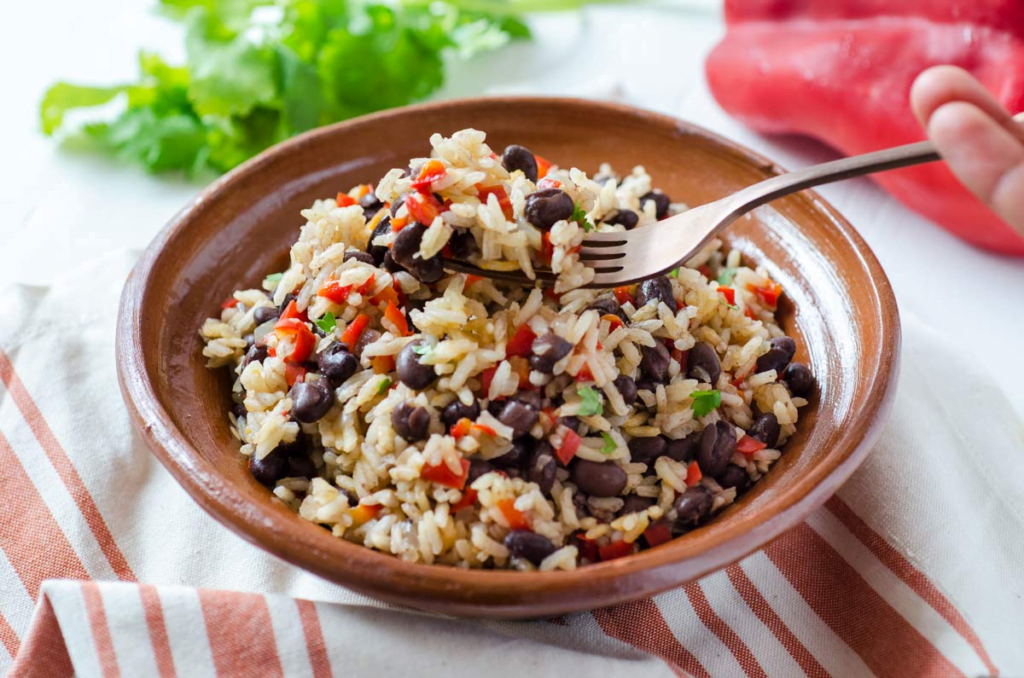
Costa Rica National Food Dish
Gallo Pinto is a popular Costa Rican national food dish. It consists of rice and black beans cooked together, often seasoned with onions, garlic, and cilantro. Gallo Pinto is a staple in Costa Rican cuisine and is typically served for breakfast alongside eggs, tortillas, and sour cream.
This is typically a breakfast meal and is a staple in Costa Rican households.
Gallo Pinto Ingredients
- 1 cup cooked rice
- 1 cup cooked black beans
- 1/2 small onion, finely chopped
- 1/2 red bell pepper, finely chopped
- 2 cloves garlic, minced
- 1 teaspoon vegetable oil
- Salt and pepper to taste
- Salsa Lizano (Costa Rican condiment, optional)
Costa Rican Cuisine – Gallo Pinto Recipe
- In a pan, heat the vegetable oil over medium heat.
- Add the chopped onion, red bell pepper, and garlic.
- Sauté until the vegetables are soft and fragrant.
- Add the cooked rice and black beans to the pan.
- Mix well and cook until everything is heated through.
- Season with salt, pepper, and a drizzle of Salsa Lizano if you have it.
- Serve your Gallo Pinto hot, either as a side dish or topped with a fried or scrambled egg.
Costa Rican Cuisine – Tamales
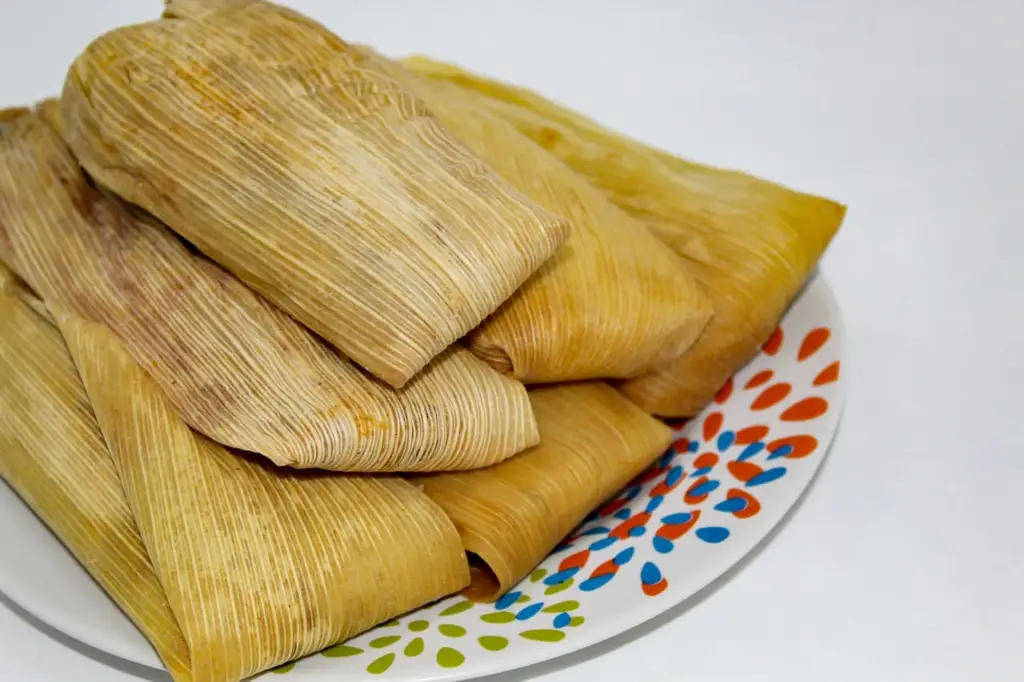
Costa Rican Cuisine – Tamales Background
Tamales are a beloved Costa Rican dish often enjoyed during holidays and special occasions. They contain corn masa dough with a flavorful mixture of meat, vegetables, and seasonings.
Costa Rican Cuisine – Tamales Ingredients
- 2 cups masa harina (corn masa flour)
- 1 cup chicken or pork broth
- 1/2 cup vegetable oil
- 1 teaspoon salt
- 1 teaspoon achiote paste (annatto)
- Filling options: cooked chicken, pork, vegetables, and olives
- Banana leaves for wrapping (or corn husks)
- Cooking twine
Costa Rican Cuisine – Tamales Recipe
- In a large mixing bowl, combine the masa harina, vegetable oil, salt, and achiote paste.
- Gradually add the chicken or pork broth to create a soft, pliable dough.
- Soak the banana leaves in warm water for a few minutes to soften them.
- Cut them into square pieces for wrapping.
- Take a piece of banana leaf and place a spoonful of masa dough in the center.
- Flatten the dough and add a spoonful of your desired filling.
- Fold the banana leaf over the masa and filling, creating a rectangular packet.
- Secure it with cooking twine.
- Repeat the process until all the masa and filling are used.
- Steam the tamales in a large steamer for 1-2 hours or until they are cooked through.
- Allow the tamales to cool slightly before serving.
- Remove the banana leaves before eating.
Presentation and Serving
Gallo Pinto is typically served as a side dish and can be accompanied by fried or scrambled eggs. It’s often garnished with fresh cilantro and a squeeze of lime for added freshness.
Tamales are served individually, and the banana leaves are removed before eating. They are often enjoyed with a cup of coffee or hot chocolate.
Matching Drinks
For Gallo Pinto, a cup of Costa Rican coffee is an excellent choice, as coffee is an integral part of the country’s culture.
Tamales pair well with traditional hot chocolate or agua dulce, a warm drink made with brown sugar and spices.
Costa Rican Cuisine – Arroz con Pollo
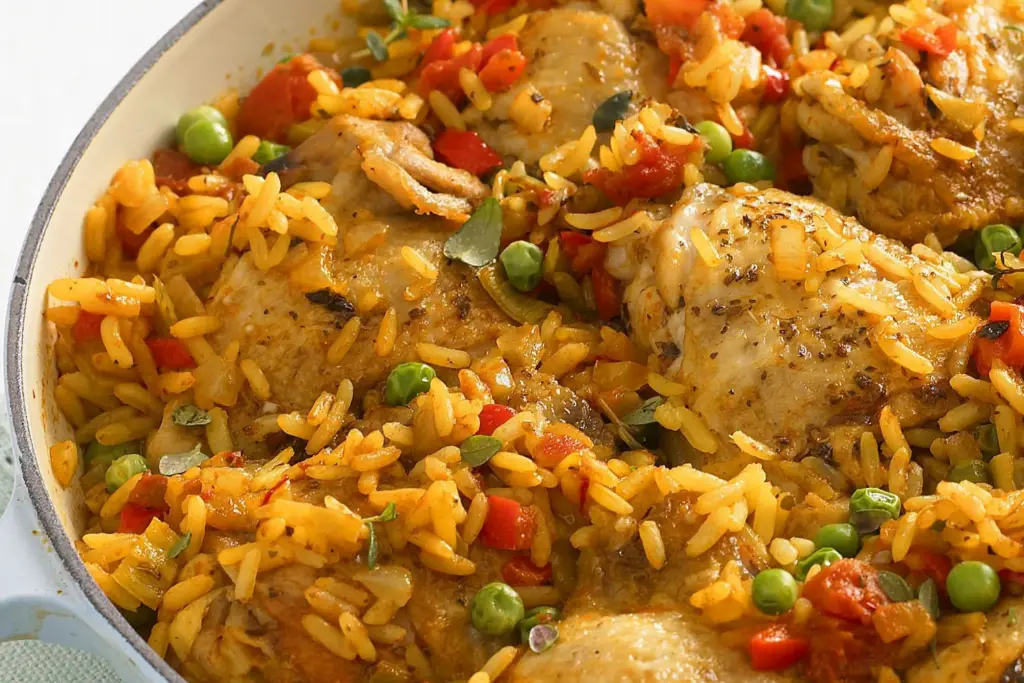
Costa Rican Cuisine – Arroz con Pollo Background
Arroz con Pollo is a comforting and flavorful Costa Rican dish that combines rice and chicken with a delightful mix of vegetables and spices. It’s a one-pot wonder that’s both delicious and easy to prepare.
Costa Rican Cuisine – Arroz con Pollo Ingredients
- 2 cups rice
- 4 cups chicken broth
- 1 whole chicken, cut into pieces
- 1 onion, finely chopped
- 1 red bell pepper, finely chopped
- 1 green bell pepper, finely chopped
- 2 cloves garlic, minced
- 1 cup peas
- 1 cup carrots, diced
- 1 teaspoon ground cumin
- 1 teaspoon ground achiote
- Salt and pepper to taste
- Vegetable oil for sautéing
- Fresh cilantro and lime wedges for garnish
Recipe Costa Rican Cuisine – Arroz con Pollo
- In a large, heavy pot, heat vegetable oil over medium heat.
- Add the chicken pieces and brown them on all sides.
- Remove and set them aside.
- In the same pot, sauté the onions, bell peppers, and garlic until they are soft and fragrant.
- Stir in the ground cumin, ground achiote, and rice.
- Cook for a few minutes to toast the rice.
- Return the chicken to the pot and add the chicken broth.
- Bring to a boil, then reduce the heat to low, cover, and simmer for about 20-25 minutes.
- Add the peas and carrots to the pot and continue to cook until the rice is tender and the chicken is fully cooked.
- Season with salt and pepper to taste.
- Serve hot, garnished with fresh cilantro and lime wedges.
Presentation and Serving
Arroz con Pollo is typically served as a wholesome main course. It’s a one-pot dish that’s perfect for family gatherings and special occasions.
It’s often garnished with fresh cilantro and lime wedges, which add a burst of freshness and flavor to the dish.
Matching Drinks
Pair Arroz con Pollo with a refreshing Costa Rican fruit drink, such as “agua fresca,” which can be made with various tropical fruits like pineapple or mango.
Costa Rican Cuisine – Casado

Costa Rican Cuisine – Casado Background
Casado, meaning “married” in Spanish, is a quintessential Costa Rican dish that typically consists of rice, beans, a protein (such as chicken, beef, or fish), plantains, and a salad. It’s a well-balanced and hearty meal.
Casado Ingredients
- Cooked rice
- Cooked black beans
- Protein of your choice (chicken, beef, fish, etc.)
- Sliced ripe plantains, fried until golden
- Fresh salad (lettuce, tomatoes, and cucumber)
- Corn tortillas
- Lizano sauce (Costa Rican condiment, optional)
Costa Rican Cuisine – Recipe
- Start by preparing the rice and beans.
- You can cook them separately, and the beans are often seasoned with onions and spices.
- Cook your chosen protein according to your preference.
- For instance, you can marinate chicken or beef with spices and grill it.
- Slice ripe plantains and fry them until they are golden and slightly caramelized.
- Assemble your Casado by placing a portion of cooked rice and beans on a plate.
- Add the protein, fried plantains, fresh salad, and corn tortillas.
- If you have Lizano sauce, drizzle it over the rice and beans.
Presentation and Serving
Casado is a staple in Costa Rican cuisine and is often served in local “sodas” (small restaurants).
It’s a well-balanced and hearty meal that’s suitable for lunch or dinner.
Matching Drinks
Pair Casado with a glass of “agua de fresco,” a refreshing fruit drink made with your choice of tropical fruits, or a “batido” (smoothie) made with fresh ingredients like mango or guanabana.
Olla de Carne Costa Rica Recipe

Background
Olla de Carne is a hearty Costa Rican beef stew, often prepared for family gatherings and special occasions. It features tender beef, a variety of vegetables, and a rich, flavorful broth.
Olla de Carne Ingredients
- 2 pounds beef stew meat, cut into chunks
- 1 onion, finely chopped
- 3 cloves garlic, minced
- 1 bell pepper, diced
- 2 carrots, sliced
- 2 potatoes, peeled and diced
- 1 cup chayote, diced
- 2 cups yam or cassava, peeled and diced
- 1/2 cup green beans, cut into pieces
- 1/2 cup corn on the cob, sliced into rounds
- 1/2 cup fresh cilantro, chopped
- 1 teaspoon ground cumin
- 1 teaspoon ground achiote
- Salt and pepper to taste
- Water
Olla de Carne Costa Rica Recipe – Recipe
- In a large pot, heat some vegetable oil over medium heat. Add the beef chunks and brown them on all sides. Remove and set aside.
- In the same pot, add the chopped onions, garlic, and bell pepper. Sauté until they are soft and fragrant.
- Stir in the ground cumin and ground achiote.
- Return the browned beef to the pot and add enough water to cover everything.
- Bring the mixture to a boil, then reduce the heat to low and simmer for about 30 minutes.
- Add the carrots, potatoes, chayote, yam or cassava, green beans, and corn on the cob to the pot.
- Continue to simmer until all the vegetables are tender, and the beef is fully cooked.
- Season with salt and pepper to taste and stir in the fresh cilantro.
- Serve hot, garnished with additional cilantro if desired.
Presentation and Serving
Olla de Carne is a hearty stew that’s often served on special occasions and family gatherings. It’s a comforting dish that brings people together, and it’s traditionally served with corn tortillas.
Matching Drinks:
Pair Olla de Carne with a warm cup of Costa Rican coffee or a glass of traditional “refresco,” a fruit drink made with a variety of tropical fruits.
Costa Rican Cuisine – Arroz con Leche

Costa Rican Rice Pudding – Arroz con Leche Background
Arroz con Leche, also known as rice pudding, is a beloved dessert in Costa Rica. This creamy and aromatic pudding is made with rice, milk, and a touch of cinnamon, making it a delightful way to end a meal.
Costa Rican Rice Pudding – Arroz con Leche Ingredients
- 1 cup white rice
- 4 cups milk
- 1 cup water
- 1 cinnamon stick
- 1 cup granulated sugar
- 1 teaspoon vanilla extract
- 1/4 teaspoon ground cinnamon (for garnish)
- Raisins (optional)
Recipe Costa Rican Rice Pudding
- In a large pot, combine the rice, milk, water, and cinnamon stick. Bring the mixture to a boil over medium heat.
- Reduce the heat to low and let the rice simmer, stirring occasionally, until it’s tender and has absorbed most of the liquid, which takes about 30-40 minutes.
- Stir in the sugar and vanilla extract and continue to cook for an additional 10-15 minutes until the mixture thickens.
- Remove the cinnamon stick and transfer the arroz con leche to a serving dish or individual serving cups.
- Sprinkle ground cinnamon on top for garnish and add raisins if desired.
- Allow the pudding to cool to room temperature or serve it chilled.
Costa Rican Rice Pudding – Presentation and Serving
Arroz con Leche is often served in individual cups or bowls, garnished with a sprinkle of ground cinnamon for a touch of warmth and flavor.
Matching Drinks
Arroz con Leche pairs wonderfully with a cup of black coffee or a glass of sweet horchata, a traditional Costa Rican drink made from rice, cinnamon, and vanilla.
Costa Rican Cuisine – Tres Leches
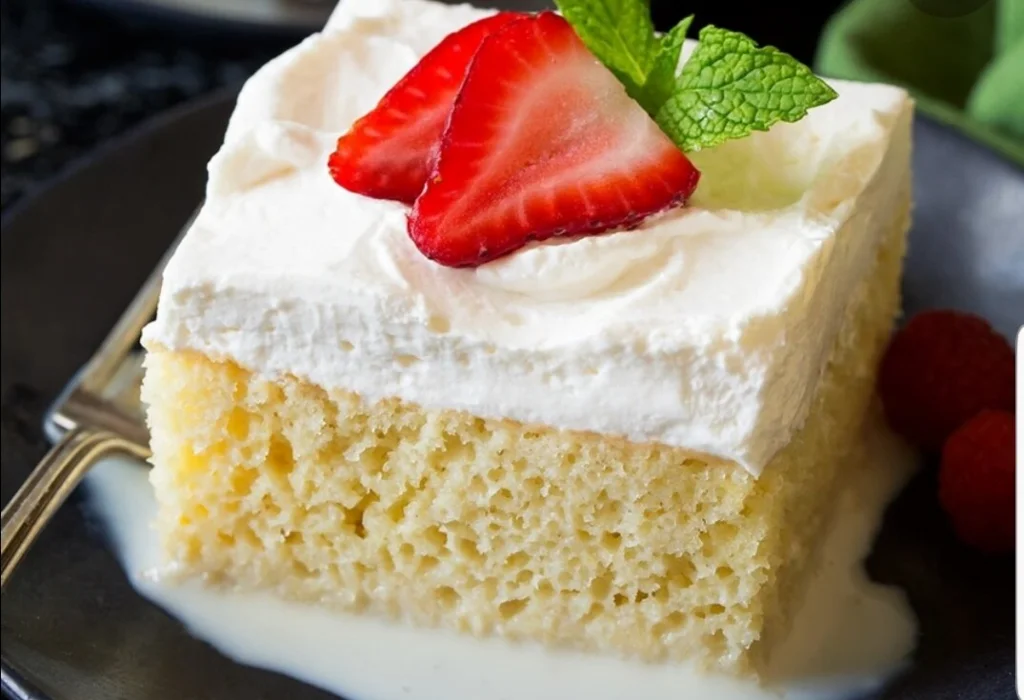
Costa Rican Cuisine – Tres Leches Background
Tres Leches, or “Three Milks,” is a popular Costa Rican dessert that’s soaked in a sweet mixture of condensed milk, evaporated milk, and heavy cream. It’s a deliciously moist and indulgent treat.
Costa Rican Cuisine – Tres Leches Ingredients
- 1 cup all-purpose flour
- 1 1/2 teaspoons baking powder
- 1/4 cup unsalted butter
- 1 cup granulated sugar
- 5 large eggs
- 1 teaspoon vanilla extract
- 1/2 cup whole milk
- 1 can sweetened condensed milk
- 1 can evaporated milk
- 1 cup heavy cream
- 1 teaspoon vanilla extract
Costa Rican Cuisine – Tres Leches Recipe
- Preheat your oven to 350°F (175°C) and grease a 9×13-inch baking dish.
- In a mixing bowl, combine the flour and baking powder.
- In a separate bowl, cream the butter and sugar together until light and fluffy.
- Add the eggs one at a time, beating well after each addition. Stir in the vanilla.
- Gradually add the flour mixture, alternating with the milk, beginning and ending with the dry ingredients.
- Mix until just combined.
- Pour the batter into the prepared baking dish and spread it evenly.
- Bake for about 30 minutes or until a toothpick inserted into the center comes out clean.
- While the cake is still warm, poke it all over with a fork or skewer.
- In a separate bowl, combine the sweetened condensed milk, evaporated milk, heavy cream, and vanilla extract.
- Mix well.
- Pour the milk mixture evenly over the warm cake, ensuring it soaks in thoroughly.
- Allow the cake to cool, then refrigerate it for at least 2 hours or overnight.
Presentation and Serving
Tres Leches is typically served in square or rectangular pieces, each drenched in the sweet milk mixture. It’s often topped with whipped cream and garnished with a maraschino cherry for a pop of color.
Matching Drinks
Tres Leches is best enjoyed with a strong cup of Costa Rican coffee or a glass of chilled horchata for a delightful contrast of flavors and temperatures.
Conclusion
Costa Rican cuisine offers a captivating journey through the flavors of a diverse and beautiful nation. With its rich history, fresh ingredients, and unique culinary traditions, Costa Rican dishes provide a delightful experience for food enthusiasts. Whether you’re exploring starters, main courses, or puddings, you’ll find a culinary adventure awaiting you in every bite.
FAQ’s
What are some key ingredients in Costa Rican cuisine?
Costa Rican cuisine relies heavily on staples like rice, beans, fresh tropical fruits, and vegetables. You’ll also find a wide array of fresh seafood and flavorful spices used in many dishes.
Is Costa Rican cuisine spicy?
While some dishes may include a hint of spice, Costa Rican cuisine is generally not known for its spiciness. It emphasizes a balance of flavors and tends to be mild in terms of heat.
What’s the significance of coffee in Costa Rican culture?
Coffee is an integral part of Costa Rican culture and plays a vital role in the country’s economy. Costa Rica is renowned for producing high-quality coffee beans, and coffee is often served with many meals.
What occasions are Costa Rican puddings like Arroz con Leche and Tres Leches typically served at?
Puddings like Arroz con Leche and Tres Leches are enjoyed at various occasions, including family gatherings, birthdays, and celebrations. They’re also a popular choice for dessert after traditional Costa Rican meals.
Are there vegetarian or vegan options in Costa Rican cuisine?
Yes, Costa Rican cuisine offers several vegetarian and vegan options, particularly dishes that feature rice and beans as their base. Many local restaurants cater to vegetarian and vegan preferences.
What’s the best way to experience authentic Costa Rican cuisine?
The best way to experience authentic Costa Rican cuisine is to dine at local eateries and seek out dishes that are popular among the locals. Exploring markets and street food is another fantastic way to sample the flavors of the country.
What is the national dish of Costa Rica?
The national dish of Costa Rica is the delectable gallo pinto, a combination of rice, beans, and spices,
Explore the Delights of Costa Rican Cuisine: A Culinary Adventure Awaits!

